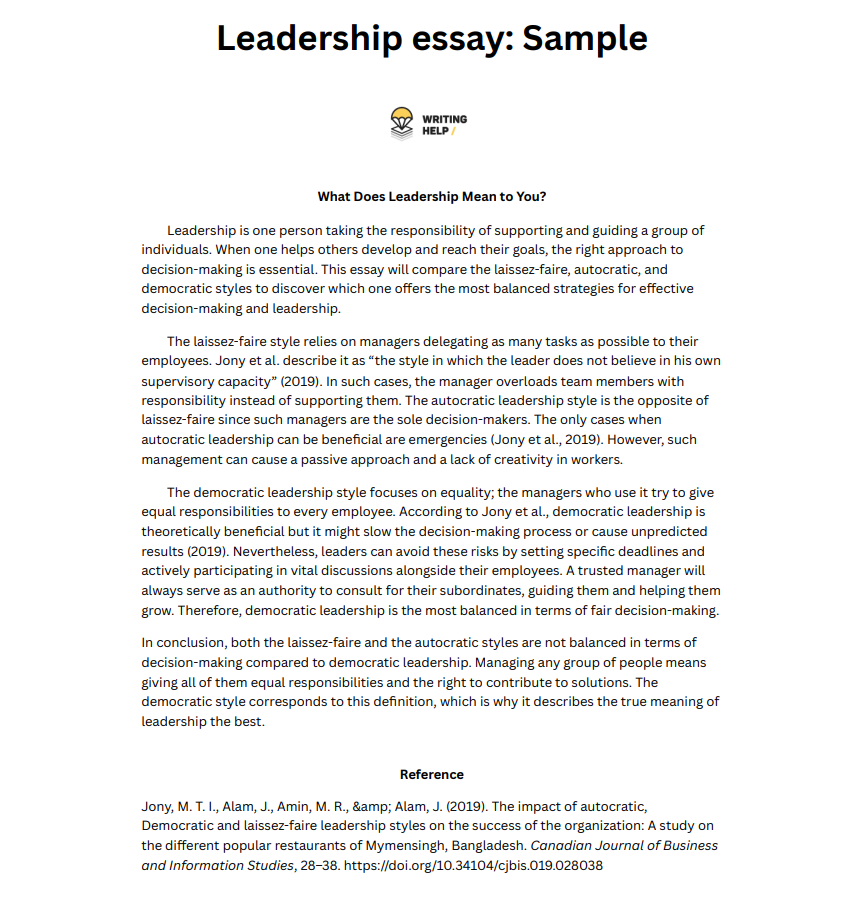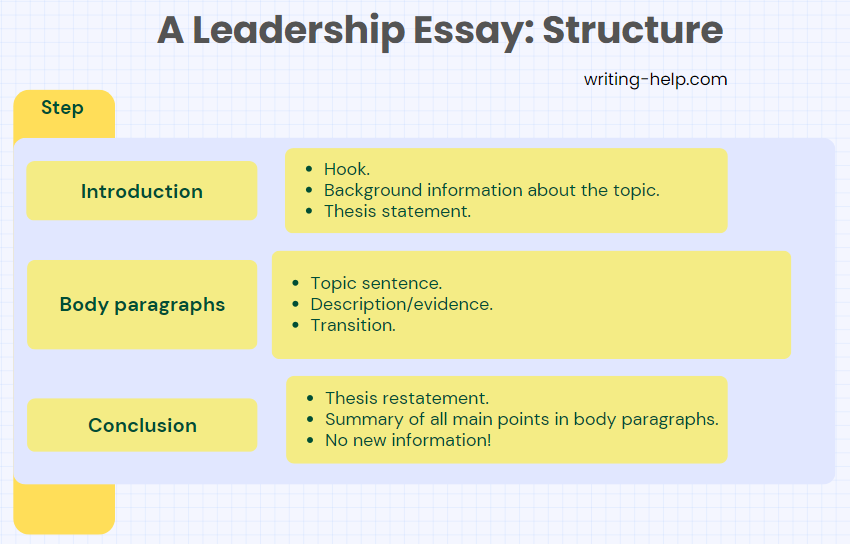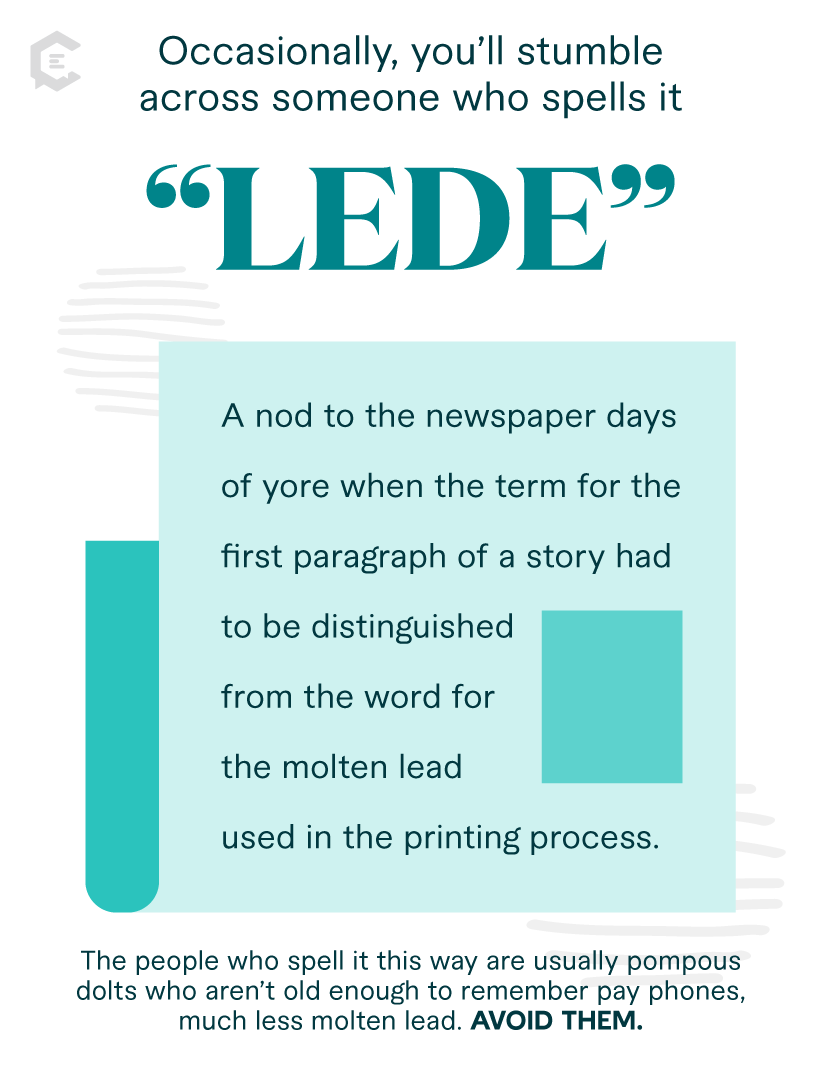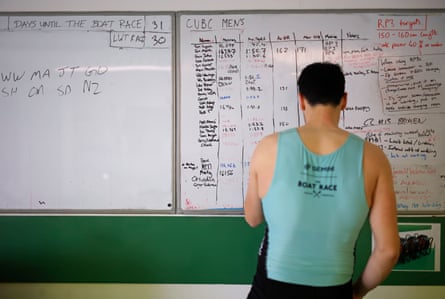Feb 15, 2023

Essays on Leadership for Students | 200 - 500 Word Essays
Are you writing an essay about leadership? Check out these examples!
Leadership is often defined as "the action of inspiring others to act in concert to achieve a particular goal." It signifies the harmony in actions that lead to a common objective. A genuine leader not only exudes confidence but also paves the way for their followers towards triumph. Over the years, various leadership styles have been identified and discussed by psychologists.
Qualities such as intelligence, adaptability, extroversion, innate self-awareness, and social competence often emerge as the hallmarks of impactful leaders. There's a consensus that these traits mold an individual into an effective leader. Interestingly, some theories suggest that extraordinary situations can thrust an ordinary individual into the spotlight, bestowing upon them the mantle of leadership. It's also believed that leadership isn't a static trait but an evolving journey. It underscores the belief that with dedication and the right resources, anyone can hone their leadership abilities.
True leadership goes beyond merely advocating for a cause. It involves taking responsibility, igniting motivation in others, and differentiating oneself from just being a 'boss'. A leader's essence lies in their ability to inspire and propel people towards grand visions, whereas a manager typically focuses on oversight and operational aspects.
What Is a Leadership Essay?
A leadership essay falls under the category of student application essays and serves to provide student admissions officers with insight into your past leadership experiences. Despite appearing to be very specific, this type of essay acknowledges that the nature and perception of leadership can vary significantly depending on the individual and the context.
If you find yourself in need of further insights or a unique angle for your leadership essay, consider exploring an expert essay-writing tool designed to assist students in crafting compelling narratives by analyzing vast data and generating fresh ideas within minutes. In this article, we'll also delve into various leadership essay examples to offer a clearer understanding of the genre and inspire your writing journey.
4 Examples of Leadership Essays
Qualities of a good leader, introduction.
Confidence is the most important attribute first of all. One of the most important qualities in a leader is confidence in one's own abilities. A lack of self-assurance is fatal to a person's leadership potential. If you want others to follow you, you need to exude self-assurance. It's imperative for a leader to have faith in his own judgment and actions. How can people want to follow him if he doesn't even know what he's doing?
Every effective leader knows that they need to be an inspiration to their followers. A leader needs to set an example for his team. In addition, he ought to inspire them whenever feasible. A leader must also maintain optimism in trying times.
What qualities a good leader must have?
Leadership is the ability to influence and guide individuals or groups toward a common goal. A leader must possess several qualities to be effective, including:
Communication skills: A leader must be able to communicate their vision and goals clearly and effectively, both verbally and in writing. This requires excellent listening skills, empathy, and the ability to adapt to different communication styles.
Emotional intelligence: A leader must be able to understand and manage their own emotions, as well as those of their team members. This includes being able to understand and respond to the emotions of others, and handling conflicts in a constructive manner.
Visionary: A leader must have a clear and inspiring vision of the future, and be able to articulate this vision in a way that motivates others to work towards it.
Strategic thinking: A leader must be able to think critically and creatively to identify and solve problems, make decisions, and develop plans and strategies to achieve their goals.
Flexibility: A leader must be able to adapt to changing circumstances and be open to new ideas and perspectives. This requires the ability to embrace change, be innovative, and continuously learn and grow.
Integrity: A leader must have strong ethics and values, and be willing to make difficult decisions that are consistent with their beliefs. This requires honesty, transparency, and accountability.
Decisiveness: A leader must be able to make tough decisions quickly, without undue hesitation or procrastination. This requires courage and the ability to take calculated risks.
Empowerment: A leader must be able to delegate responsibilities, give team members the resources they need to succeed, and foster a sense of ownership and accountability among their team.
Conclusion
These qualities are essential for effective leadership, and when combined with hard work, determination, and a commitment to excellence, can help leaders to achieve great things.
How one can be a Great Leader?
Leadership is the act of performing the duties of a leader. In the business world, for instance, it is essential to have someone in charge of a team to ensure everything runs well. Effective leadership is essential for any group that wants to maximize its prospects of success.
Leadership Comes from Experience
As we've shown, leadership can be innate in some cases but is more often learned through practice and exposure. Sometimes the best traits of a leader must be learned over a lengthy period of time, so that one can become a notable one, proving that leadership is not always about a person's innate qualities. Leaders should continuously be on the lookout for opportunities to grow their leadership skills.
Nobody can disagree that experience is a key component of leadership. Numerous examples exist to back up this claim, such as:
Instance 1:
Our school's head boy or girl has traditionally been an older student who has been around for a while and thus has a better grasp of the ins and outs of school politics.
Instance 2:
When there is a vacancy for a team leader, it is common practice for the employee who has consistently put in the most effort and attention to the office job to receive a higher number of votes than their coworkers.
“The best teacher for a leader is evaluated experience.” - John C. Maxwell
How one can be a Great Leader/Skills to be a Great Leader?
Effective leadership is a skill that develops through time. Developing into a leader with all the qualities that are needed takes a lot of hard work and potential. Being a prominent leader calls for a wide variety of traits. Some of these characteristics are addressed in further detail below:
One should be a Good Communicator
To be an effective leader, one must be able to convey his thoughts clearly to his/her/its subordinates.
Should have Confidence
The individual should have faith in what he says and does.
Give Credit to other Team Members too
A leader not only needs to impose his viewpoints and opinions instead he must also hear to the suggestions of other members of the team and offer them credit if their concept is appropriate.
Good Bond with the Team
A leader's ability to command respect from his team members depends on his ability to develop and maintain positive relationships with them.
Leads with Responsibility
A leader needs to be completely committed to his position. It's important that he takes on responsibility so that he can effectively deal with the various challenges he will inevitably face.
Any group or organization needs a leader above all else. Leadership development takes time and effort. One needs to have lived through a lot to be an effective leader. It's not enough to simply have years of experience in the field; one must also have the traits that make one an effective leader. You can't be a great leader unless you possess certain traits.
What makes a Good Leader?
Trying one's hand as a leader appears easy when viewed through this lens. Is that so tough? Of course not; leading is difficult, and not everyone aspires to be a leader. The vast majority of us have settled into well-established careers where we report to superiors and make a living. Still, not everyone is content to go along with the crowd. They become leaders in whatever field they pursue. A leader is an example to followers and will prioritize the needs of those around them.
Some Unique Qualities of a Leader
Many individuals resort to their leaders to vent their frustrations, therefore it's important for them to be good listeners.
A leader ought to be completely forthright; they can't play favorites or give anyone preferential treatment. One of the most essential qualities of a strong leader is the ability to make decisions with integrity.
They need to be aware of the bigger picture and understand what makes an individual stand out or become a leader. It's their expertise in addition to other distinguishing traits. Their awareness of current events and the results of recent studies is essential. In many ways, this is helpful, and it's the leader's responsibility to stay current.
Since some might not understand them, they should utilize straightforward, easily comprehended language. Leaders need to be able to communicate effectively at all times. In reality, what sets them apart is their exceptional communication skills. Adolf Hitler was such a gifted orator that his followers believed every word he said.
No matter how you're feeling or what's going on in the world, if you listen to a leader, they may make you feel energized. Since leaders are in charge of inspiring confidence in their followers, they can't afford to be wary or unsure of themselves. People tend to blindly follow their leaders.
Whether you're a leader or a doctor, you should devote yourself completely to your chosen field. Everything we do is for the benefit of others; engineers, for example, spend much of their time designing and constructing buildings for other people. So, take pride in what you do, and if you possess the aforementioned traits, you are also a leader who doesn't have to rely on others to succeed. No matter what you do, aspiring to leadership positions will always benefit others.
What is Leadership in Management and what are the weaknesses and strengths of a Leader?
Simply said, leadership is acting as a supervisor or manager of a group. Different mental pictures pop up when we hear the word "leadership" used in conversation. One might think of a political leader, team leader, corporate leader, school leader, etc. Leaders facilitate order and efficiency in the workplace. Teamwork and success are fundamental to effective leadership. Leaders utilize their managerial abilities to establish courses and guide their teams to success.
Strengths and Weaknesses of Leadership
Able to express oneself more clearly
Growth of character.
Self-awareness.
Possession of teamwork skills.
Gain assurance in yourself.
Weaknesses:
Acting favorably toward one's teammates.
Having no faith in the leader.
Thinks they're better than everyone else, but act hypocritically.
Not living up to the promised standard.
Insufficient morals.
Leadership and Management
Management and leadership are inextricably linked to one another. Leadership and management are both vital to the efficient operation of an organization; but, they accomplish very different things in the process. Leadership is a necessary skill for anyone aspiring to be an effective manager. The terms management and leadership are synonymous with one another. In this manner, we are able to draw the conclusion that a manager who demonstrates the traits of a successful leader is, in fact, a manager who is effective.
Leadership in School
Leadership is essential in nearly every group, as we've seen above. That group includes one's educational institution. Every school needs an outstanding figure to serve as its head of school. Class monitor, assembly captain, cultural leader, etc. are all examples of leadership roles that can be taken on at school, but this raises the question of what makes a person a successful school leader.
Any student hoping to be chosen as a student body leader will need to demonstrate a wide range of competencies. He or she needs to be a consistent student who pays attention in class and does well in extracurricular activities. For the simple reason that no intelligent and hardworking kid would ever be considered for leadership. Student leaders are most often selected from among those who participate fully in all activities.
Leadership in Organization
Leadership in an organization, also known as organizational leadership, is the process of establishing long-term objectives that further the company's mission and help it reach its ultimate destination. This is a classic illustration of how Bill Gates often works with his team: they agree on a strategy, and Gates implements it. To the same extent, it is the responsibility of the leader in each given organization to determine what it is that the group is trying to accomplish.
Leadership in Politics
Leadership in politics, also known as political leadership, is the process of becoming actively involved in a political party in the role of a party leader. Knowledge of political processes, their outcomes, and the political agenda is central to the idea of political leadership.
An effective leader can be developed in anyone who has the determination and drives to do so. Both the strengths and the areas for improvement should be nurtured. Whether in the classroom, the workplace, or the political arena, leadership is always necessary. Therefore, one can exercise leadership anywhere they like inside their own organization.
What are the types of Leadership?
The ability to lead is a rare trait that not everyone possesses. The ability to do so is a gift, so count your blessings if you possess it. It's recommended that you hone it even more so that you can propel your career forward and serve as an example to people around you. However, it is crucial to grasp the various leadership styles before you go ahead and polish your skills.
Types of Leadership Styles
Democratic Leadership
In this style of management, subordinates are given a voice in decision-making. Although the subordinates' efforts are highlighted, the leader is ultimately held responsible for the group's actions. Many people find this type of leadership to be effective.
Transformational Leadership
Transformational leaders motivate and inspire others to adopt new behaviors and ways of thinking in order to improve their own performance and that of their teams and organizations. A transformational leader is someone who encourages their team to strive for greater things and works to boost morale and output.
Team Leadership
A good leader fully incorporates his team into the task at hand. Members of the team are motivated to reach their goals and advance in their careers thanks to the leadership of the group.
Strategic Leadership
It requires a chief executive who doesn't restrict himself to brainstorming sessions with his superiors. He contributes on every level of the team. He is well-liked for his ability to unite the need for fresh ideas with the necessity of grounding them in reality.
Autocratic Leadership
The leader in a command and control structure is the center of attention. The chief executive has absolute power in this setting. He decides things on his own, without polling his staff. He relays this information to his staff and stresses the importance of swift action. The buck stops with him, and he alone must answer for his actions. Not much room for negotiation exists. It's no secret that this method of leading has its detractors.
Visionary Leadership
This kind of leader appreciates the abilities and requirements of his team members. He describes his ideal outcome and the teamwork that will be necessary to attain it.
Coaching Leadership
Leaders who coach their teams do so regularly in an effort to raise output. He inspires his employees to do better and works to keep them motivated. This approach to leadership has been much praised.
Facilitative Leadership
With occasional guidance, a facilitative leader ensures that the process runs smoothly for his team. As a precaution in case his team is ineffective. If the team is highly effective, the leader will take a hands-off approach.
Cross-Cultural Leadership
The leadership of this type is necessary when interacting with people from various cultural backgrounds. Because of the wide variety of cultures represented in the workforce across the United States, many managers and executives hold cross-cultural positions.
Laissez-Faire Leadership
The members of the team are given responsibility in this style of management. They are free to choose how they spend their time at work, with minimal oversight from the boss. It's not a good way to lead, according to experts.
Transactional Leadership
An interactive approach is integral to this kind of leadership. When team members successfully implement their leader's ideas and choices, they are rewarded with immediate, material benefits.
Charismatic Leadership
In order to bring out the best in his followers, this kind of leader makes the effort to change their attitudes, values, and actions.
This article should dispel the notion that leadership qualities can't be further subdivided. It should also assist you in pinpointing your own personal brand of leadership so you can perfect it over time.
Final Words
In conclusion, leadership is a complex and multifaceted concept that involves various qualities and skills. Effective leaders possess traits such as integrity, vision, empathy, decisiveness, and the ability to inspire and motivate others. They are able to navigate challenges, make difficult decisions, and lead their team toward success. Leadership also involves continuous learning and self-improvement, as leaders must adapt to changing circumstances and remain relevant. Effective leadership can have a positive impact on both individuals and organizations, fostering growth and creating a culture of success.
You can use Jenni.ai to quickly compose an essay on leadership, or any other topic, of your choosing. It's a fantastic choice that promises convenience and relief. Create an essay on any topic in a matter of minutes with the help of our AI-powered program. Membership is immediately available upon your free registration here.
You can use Jenni.ai to quickly compose an essay on leadership, or any other topic, of your choosing. It's a fantastic choice that promises convenience and relief. Create an essay on any topic in a matter of minutes with the help of our AI-powered program. Sign up on Jenni.ai and get a free trial.
Try Jenni for free today
Create your first piece of content with Jenni today and never look back

How it works
Transform your enterprise with the scalable mindsets, skills, & behavior change that drive performance.
Explore how BetterUp connects to your core business systems.
We pair AI with the latest in human-centered coaching to drive powerful, lasting learning and behavior change.
Build leaders that accelerate team performance and engagement.
Unlock performance potential at scale with AI-powered curated growth journeys.
Build resilience, well-being and agility to drive performance across your entire enterprise.
Transform your business, starting with your sales leaders.
Unlock business impact from the top with executive coaching.
Foster a culture of inclusion and belonging.
Accelerate the performance and potential of your agencies and employees.
See how innovative organizations use BetterUp to build a thriving workforce.
Discover how BetterUp measurably impacts key business outcomes for organizations like yours.
A demo is the first step to transforming your business. Meet with us to develop a plan for attaining your goals.

- What is coaching?
Learn how 1:1 coaching works, who its for, and if it's right for you.
Accelerate your personal and professional growth with the expert guidance of a BetterUp Coach.
Types of Coaching
Navigate career transitions, accelerate your professional growth, and achieve your career goals with expert coaching.
Enhance your communication skills for better personal and professional relationships, with tailored coaching that focuses on your needs.
Find balance, resilience, and well-being in all areas of your life with holistic coaching designed to empower you.
Discover your perfect match : Take our 5-minute assessment and let us pair you with one of our top Coaches tailored just for you.

Best practices, research, and tools to fuel individual and business growth.
View on-demand BetterUp events and learn about upcoming live discussions.
The latest insights and ideas for building a high-performing workplace.
- BetterUp Briefing
The online magazine that helps you understand tomorrow's workforce trends, today.
Innovative research featured in peer-reviewed journals, press, and more.
Founded in 2022 to deepen the understanding of the intersection of well-being, purpose, and performance
We're on a mission to help everyone live with clarity, purpose, and passion.
Join us and create impactful change.
Read the buzz about BetterUp.
Meet the leadership that's passionate about empowering your workforce.
For Business
For Individuals
7 ways you can lead by example (and why it matters)

Lead with confidence and authenticity
Develop your leadership and strategic management skills with the help of an expert Coach.

Jump to section
What does "lead by example" mean?
Why is it important to lead by example.
What can happen when you don’t lead by example?
7 ways to lead by example
2 instances of leading by example, put your new skills to work.
Have you ever wondered what separates a strong team from a weak one?
The answer is usually: their leader.
Strong teams have ethical leaders that lead by example . They shine a light on the path ahead. They also show employees how to handle failure and what kind of behaviors they should have.
In return, employees mirror their leaders’ behavior. They walk in their footsteps, learn from their mistakes, and contribute meaningful ideas.
Before we cover how to lead by example, let’s review what leading by example means and what can happen when you don’t.

The mark of a good leader lies in their ability to "walk the talk." In this section, we’ll review what it means to lead by example.
To lead by example means to guide others through your behavior instead of your words. Your intention is to inspire others to copy your behavior.
The opposite of leading by example is to say one thing and do another. The saying “do as I say, not as I do” may have worked in the past, but it has no place in today’s world.
Modern employees want to see that your actions mirror what you say. This means aligning your habitual practices, routines, and behaviors with your core values .
That doesn't mean that you get it right every time. But employees are quick to notice inconsistency and contradictions in their managers and leaders. Alignment is at the heart of being an authentic and genuine leader .
In the end, the purpose of leadership is to be the change you want to see in your organization.

In this section, we’ll explain four reasons why it’s important to lead by example:
1. Boosts employee morale
A great leader knows that their actions influence employee attitude, satisfaction, and performance. When leaders lead by example, morale goes up . This leads to greater company loyalty and higher productivity.
2. Builds trust and respect
Someone who leads by example can expect to receive trust and respect from their team. Superiors see them as someone who is capable of running a team, and employees see them as trusted mentors.
A trusted leader can also inspire teammates to respect and trust each other . This organizational cohesiveness can increase customer loyalty.
3. Fosters a positive work culture
Workplace culture is the character of an organization. It may include the business’s goals, work practices, beliefs, and behaviors.
Businesses that have leaders who "walk the talk" embody these values daily. This commitment to workplace values inspires a positive work culture and happy employees.
4. Increases productivity
It’s easier for teams to be productive when they see their leader doing the hard work, keeping commitments, and focusing on shared outcomes. There tends to be a deeper desire to work hard and do work that makes the team proud.
When a leader's actions and words align, the team doesn't waste energy trying to decode their intent or agenda. Through example, leaders also teach their teams to develop more effective and efficient processes.
In this section, we’ll share what can happen when you don’t lead by example.
1. Low work ethic
When you don’t set a good example, one of the first things to go is work ethic. Your followers will struggle to perform well if they see you performing poorly.
2. Low morale
One of the quickest things that kills workplace mood is poor leadership. It’s challenging for employees to feel satisfied and motivated if they don’t have a leader they trust.
3. High turnover rate
Hiring and training new employees is one of the most costly parts of a business. Employees who answer to poor leaders have a higher rate of churn.
4. Inefficient systems
Leaders who lead by example show their teams how to do things faster and better. They demonstrate systems thinking and a continuous improvement mindset. But poor leaders don’t take the time to teach their teams how to be efficient. They don't demonstrate how to take a critical view of systems and processes.
Without manager support, teams scramble to figure things out the hard way. This can lead to ineffective and inefficient systems.
5. More workplace accidents
Employees look to their leaders for clues about what is actually valued or important in the organization. When leaders don't model safe behavior, teams learn that it is not a priority. Without a good role model, teams may miss or ignore important workplace safety training. This can lead to costly mistakes and workplace accidents.
6. Lack of trust and respect
Employees question leaders that don’t lead by example. They struggle to trust their manager’s decisions and leadership style .
Here are seven ways to lead by example:

1. Sharpen your leadership skills
One of the best ways to lead by example is to learn how to do it. This means taking advantage of the best leadership training you can get your hands on.
Training can help you build the skills, mindset, and behaviors needed to perform at your peak. Not only can this help you be a better leader, it can also help you build more resilient teams .
2. Be constructive when handling conflict
You can’t expect your employees to handle conflict well if you don’t. This means addressing conflict calmly and productively. The goal is to diffuse the tension and work toward a solution.
For instance, let’s say your superior is questioning you in front of your team. He’s confused why you ordered more inventory than usual, and he’s upset about the high cost.
Instead of defending your decision, first acknowledge his concern. Then — briefly and neutrally — explain your reasoning and follow it up with a solution.
For example, you could say:
“I hear you. I did order a higher amount than usual, and I can see why you’re worried. The reason I ordered more inventory is that next month is a major holiday, and we've been running low. I wanted to be sure we would have enough stock for our customers.
Last year we sold out fast, and our customers weren’t happy. How about next time I can let you know before I make a big buy? Would that be okay?”
3. Communicate kindly
Beyond handling conflict, a healthy dialogue is important for all interactions. This demonstrates that you care about your team and customers.
When you go into the office or into a call, greet your team with a smile and a warm "hello." If an employee comes to you with a question, answer it politely.
If a customer complains, respect their concerns and help them find a solution.
4. Bounce back after failure
Failure is a natural part of life and business. It can happen anytime we take risks or make decisions.
If we feel defeated and ashamed of failure, it can prevent us from trying again. It can also spill over into other areas of our lives, keeping us from reaching our fullest potential .
One of the best ways to inspire your employees to perk up and try again is by showing them how .
Did you lead a new product launch that failed to produce sales? Tell your team what you learned from your mistake. Did you help scale a sister company too early? Explain what went wrong and head to business training.
The key is to dust yourself off and try again, encouraging your employees to do the same.
5. Practice ethical leadership
Ethical leadership means behaving according to a set of strong moral principles. These values include integrity, fairness, honesty, respect, and transparency .
Ethical leadership is a conscious way of perceiving the world around us. It helps us understand our circumstances and respond in healthy ways.
To practice ethical leadership, align your goals and actions with strong values . Here are some ways to practice ethical leadership:
- Report unethical behavior
- Do the right thing even when nobody’s watching
- Own up to your mistakes
- Be reliable and dependable
- Treat all employees fairly
- Value every team member
- Follow the rules
- Set the standard for excellence
6. Celebrate diversity
Leading by example means embracing employees from all walks of life .
To celebrate diversity, be adamant about hiring a diverse team of employees.
Here are some other ways to celebrate diversity:
- Create policies and procedures that make all individuals feel welcome.
- Be open-minded and encourage different perspectives.
- Listen to and recognize team members.
- Make sure each employee has an equal chance at a professional opportunity.
- Host employee events that celebrate different cultures.
Creating a workforce where all team members feel equal is one the most important ways to lead by example.
7. Take care of yourself
Taking care of yourself and self-care is essential for your well-being and your team’s. After all, it's difficult to be a good leader if you’re not feeling well.
To perform at optimal levels, take care of your physical, emotional, and mental health. Drink plenty of water, get enough sleep, and eat healthy meals every day.
You’ll also need coping tools to manage your stress levels and emotions .
Here are two instances of leaders leading by example:
Leading by example 1
Julie is a manager at a local bank with a small team of seven employees. When she walks into work, she greets her team with a smile and asks how their day’s going.
She then calls everyone into a morning meeting. Instead of leading with her agenda, Julie gives each employee a chance to voice ideas. She celebrates their ideas and asks them to create a proposal to bring their ideas to life.
Afterward, she moves on with her agenda and answers questions along the way. After the meeting, she offers to help her employees with their proposals. They happily accept her help, and the team works together to create an action plan.
Leading by example 2
Sam is a customer service manager for a phone company. He shows up to work a few minutes early every day to plan his agenda.
When his team starts to arrive, he greets them warmly and asks them what they did the night before.
Afterward, he begins to praise each team member for their work efforts from the day before. He even recognizes each employee for a specific skill they showed.
When it’s time to start answering calls, Sam grabs a headset like he does every day. When he’s not putting out fires or helping employees, Sam answers calls like the rest of the team.
Now that you have a better idea of what it means to lead by example, it’s time to put your new skills to work.
Here’s a simple exercise you can use to set your intention and keep yourself accountable:

Before work
Ask yourself:
- How can I show up for my team today?
- What does my team need help with?
- What do I want them to do that I should also be doing?
- How can I recognize my team today?
During work
Ask yourself:
- Am I living up to the standards I want my employees to live up to?
- What can I do right now to model ethical behavior?
- What do I need to help my employees with right now?
- Am I focusing on important tasks?
- Did I show excellence today?
- If so, what did I do right?
- If not, what should I do next time?
- How can I be a better leader tomorrow?
Leading by example: helping others tap into their potential
Leaders lead by example when they set the standard of excellence they want their employees to follow. With strong ethical values and practices, you can help your team reach its potential. Leading by example proves to your team that what you say and do matters.
Need help getting there? At BetterUp, we love helping teams thrive. Request a demo to find out more .
Maggie Wooll
Maggie Wooll is a researcher, author, and speaker focused on the evolving future of work. Formerly the lead researcher at the Deloitte Center for the Edge, she holds a Bachelor of Science in Education from Princeton University and an MBA from the University of Virginia Darden School of Business. Maggie is passionate about creating better work and greater opportunities for all.
Power lead your next conversation
What is organizational structure and why is it important, introducing betterup, and why everyone needs a coach in their corner, how to make decisions like a multi-billion dollar corporation, be the change you want to see: 6 tips to succeed at leading change, why we need to reframe potential into readiness, 10 examples of principles that can guide your approach to work, a new role for chros: insights from the gartner reimaginehr conference, succeed at work by learning how to manage up: 8 tips for doing it well, similar articles, what is groupthink and how do you avoid it, looking inward can make you a better leader, the importance of being an ethical leader and how to become one, redefining professionalism in the workplace, what is referent power your guide as a leader, multicultural competence: 8 ways businesses can work with culture, how to give positive comments to your boss, building influence at work: be the best leader you can be, 6 winning strategies to improve team dynamics, stay connected with betterup, get our newsletter, event invites, plus product insights and research..
3100 E 5th Street, Suite 350 Austin, TX 78702
- Platform Overview
- Integrations
- Powered by AI
- BetterUp Lead
- BetterUp Manage™
- BetterUp Care™
- Sales Performance
- Diversity & Inclusion
- Case Studies
- Why BetterUp?
- About Coaching
- Find your Coach
- Career Coaching
- Communication Coaching
- Life Coaching
- News and Press
- Leadership Team
- Become a BetterUp Coach
- BetterUp Labs
- Center for Purpose & Performance
- Leadership Training
- Business Coaching
- Contact Support
- Contact Sales
- Privacy Policy
- Acceptable Use Policy
- Trust & Security
- Cookie Preferences
Essays About Effective Leadership: Top 6 Examples and Prompts
Effective leadership is an essential trait that all people should strive to develop; here are 6 examples and topic ideas essays about effective leadership .
Many qualities make an inspiring and effective leader, such as vision, focus, and motivation. Like other skills, effective leadership can be innate or learned and practiced. When writing about leadership, include the strengths of an effective leader and how these qualities positively impact their team. You can also discuss weaknesses that can make a poor leader and how to combat these issues.
Here are 6 examples and 10 essay prompts to get you started on your next essay.
1. What Makes an Effective Leader? by Tony Gill
2. a guide to becoming an effective leader by yashi srivastava , 3. leadership: 5 practices of effective leaders by yvette gyles, 4. 6 characteristics of an effective leader by lauren landry, 5. six leadership lessons by order of the peaky blinders by andrew denton mbe, 6. leadership and the quest for certainty by keith grint, 1. what is effective leadership, 2. what does effective leadership look like in the corporate industry, 3. what to avoid to become an effective leader, 4. habits of an effective leader, 5. studying the mindsets of effective leaders, 6. effective leadership and its benefits to an organization, 7. indicators of strong and effective leadership, 8. poor leadership vs. effective leadership, 9. real-life examples of effective leadership, 10. how perception creates effective leadership.
“Work at using leadership styles that do not come naturally, styles that you find difficult. By becoming a well-rounded leader, it is easier to adapt your leadership technique for different situations.”
Gill uses a research-based approach to answer the central question of his essay. He looks at various sources that tackle the topic of effective leadership and stitch them together to make a comprehensive guide to effective leadership.
“Leadership is not a mystical quality, and anyone can become a more effective leader by developing some important skills.”
The author, Yashi Srivastava, defines what differentiates leaders from managers first. Then, she provides some dos and don’ts of an effective leader and how people could apply them in different situations.
“Whereas as leaders, we need to be concerned about creativity and innovation, making positive changes, and seeking to challenge and push boundaries.”
Gyles specializes in leadership training for companies, so her approach to the essay is geared more toward company leaders. Nevertheless, it’s highly educational for all those interested in learning effective leadership meant for dealing with various people and guiding people to a direction or goal.
“Effective leaders don’t avoid the hard truths. Instead, they take responsibility for their decisions, maintain optimism, and focus on charting a new course of action.”
Landry’s essay focuses on her six top characteristics of an effective leader. Some of these characteristics are what you’d expect to see in an essay like this. Entries like transparency are less common but equally important in practicing effective leadership.
“Rolling your sleeves up with everyone else not only sets an example, it makes people want to follow you.”
Fiction mirrors life, and it’s one of the best sources to learn lessons that are otherwise too complex or vague to see in real life. Despite his penchant for crime and violence, Thomas Shelby is undeniably one of the most influential leaders on TV. This essay details the leadership skills used by a 1920s gangster character and how you can use them in modern life to become an effective and inspiring leader.
“Leadership is often associated with certainty; indeed, it is sometimes reduced to the decision-making process such that anything which smacks of uncertainty is categorized as weakness or a failure of leadership.”
Grint’s essay on leadership explores the factors around leaders’ certainty or confidence. Of course, not all leaders have a clear answer to a problem, which is fine. The important thing is that they have a mindset to look for solutions and a modicum of honesty about their lack of uncertainty.
10 Essay Prompts on Effective Leadership
It’s your turn to express and explore your view of effective leadership. Use these prompts to work out your approach or steps to effective leadership. Here are ten prompts about effective leadership to help you get started on your essay.
Defining effective leadership is one way to explore your understanding of the idea. Remember that your definition of effective leadership could vastly differ from the other essays you’ve read. It’s also a great starting point for new people who want to warm up to the habit of writing essays about leadership.
Essay writing tip: If you’re new to writing essays, consider simplifying your essay. Try shortening it down to a five-paragraph essay .

You can find many leaders in the corporate industry, but some are more effective than others. Use this prompt to work out how you envision effective leadership in the corporate world. You can also apply the same idea to other fields, like at school, among friends or peer groups, or in the family. Consider carefully the field or organization you’d like to use for the essay.
You may have personal experience with a person who could have been an effective leader if not for their bad habits. You might have been that person and realized how your bad habits had held you back from practicing effective leadership. This is your chance to write about your experience, whether via observing someone else or through personal growth.
Practicing effective leadership goes beyond having direction and a vision for the organization. Becoming an effective leader also takes time and patience. Use this prompt to discuss the habits of great leaders and how these habits make them effective in their leadership.
Get into the mind of a leader and explore how such a person might become more effective in their leadership. This topic may involve discussing various people, whether real-life persons or fictional characters. Research how they think, handle their role and manage the people they lead.
Understanding the benefits of effective leadership is one of the best ways to drive someone to practice and adopt it. Use this prompt to detail how an effective leader boosts morale, productivity, motivation, communication quality, and confidence in the people they lead. It applies to all organizations, like businesses, teams, and networks.
How do you know whether a person’s leadership style and approach are effective or not? Use this essay topic to discover the different methods of measuring effective leadership. Read about the different measurements and indicators of leadership used in corporations and organizations.
Leaders can be good, mediocre, or bad in their leadership approaches and styles. This essay prompt will push you to compare bad leadership and effective leadership. You can also add methods of improving one’s leadership style to become more effective.
You can find a lot of excellent leaders throughout history. This idea focuses on discussing different leaders, their leadership styles, and levels of effectiveness.
Interpersonal skills are vital to great leadership. Perception of others’ feelings and thoughts can help you become an even better and more effective leader. Discuss how intuitiveness positively affects one’s leadership style.
Check out our list of great essay writing topics for students for more topics to improve your writing.

Maria Caballero is a freelance writer who has been writing since high school. She believes that to be a writer doesn't only refer to excellent syntax and semantics but also knowing how to weave words together to communicate to any reader effectively.
View all posts
- SUGGESTED TOPICS
- The Magazine
- Newsletters
- Managing Yourself
- Managing Teams
- Work-life Balance
- The Big Idea
- Data & Visuals
- Reading Lists
- Case Selections
- HBR Learning
- Topic Feeds
- Account Settings
- Email Preferences
Like It or Not, You Are Always Leading by Example
- Michael Schrage
So make sure you know what it means.
Even the most sophisticated psychometrics and people analytics have yet to make leadership development more science than art. Competence, character, creativity, and charisma remain difficult qualities to quantify, let alone cultivate. Growing effective leaders is challenging work.
- MS Michael Schrage , a research fellow at MIT Sloan School’s Center for Digital Business, is the author of the books Serious Play (HBR Press), Who Do You Want Your Customers to Become? (HBR Press) and The Innovator’s Hypothesis (MIT Press).
Partner Center
Leadership Essay
27 August, 2020
12 minutes read
Author: Richard Pircher
As a college student, you must write essays on a regular basis since the latter is one of the most common types of home assignments. All this means is that in order to get good grades and be successful with writing the papers, you need to have a sound understanding of the structure. Additionally, what you should never neglect is the variety of essay types. Indeed, your essay will significantly differ from one type to another: description essay will most likely have a structure that is slightly different from an argumentative one.

What you may have already encountered in your academic life is the work on a leadership essay. Although it sounds pretty complicated and vague, it is mostly possible to master an essay on leadership. Below is a guide for you to get an insight into this particular essay type.
What is a good leadership essay?
A good leadership essay is the one in which the essay writer has fully covered the topic of leadership and understood its core ideas. More specifically, to end up with a flawless leadership essay, you will need to indicate what makes a person a good leader. For achieving the latter, you will most likely need to conduct research and trace how a particular person reaches his or her goals. In other words, the task is to discover which actions the person undertakes, what their followers say about him or her, and how the person organizes the work. So, a leadership essay implies providing real-life success examples and further revealing them.
Above all, a good leadership essay is the one that follows a precise, clear, comprehensive structure. Structuring your essay about leadership in the most coherent way leads to a win-win situation: you have fewer troubles and barriers to writing a brilliant essay, and your teacher is able to comprehend the essay easily. This guide is what you will need to refer to to get an insight into how the flawless structure for a leadership essay looks like and how it will let you take a benefit.
How to write a Leadership essay?
To write a leadership essay that stands out, you first need to brainstorm all the ideas that you have and come up with a topic for your essay. If you are struggling with this step, you may think of some of the most influential people, read about them, and find out what makes them unique. Or, you can pick any topic which is mentioned at the end of this article. After you have chosen an issue, it is time to structure your essay appropriately.

As you already know, an essay constitutes three essential sections: introduction, main body, and conclusion. Below is the more detailed description of each of the parts.
Introduction
Of course, your leadership essay introduction will always vary depending on the topic of the essay. However, you can always begin by stating your vision of leadership regardless of the topic. Additionally, to motivate the reader and instantly catch his or her attention, you may use a quote of a famous leader, or simply a quote which you find relevant to the topic. Be aware that you should avoid outlining the essence and the role of the leadership in your introduction; leave it for the body paragraphs.
What you may also do in your leadership essay is ask a question, which will most likely intrigue the leader. Or it will at least give your reader an overview of what you will dwell on in your essay.
Body Paragraphs
You will need to divide the main body into 3-5 paragraphs to make the structure more comprehensive. What you have to do at this point is give your reader a sound understanding of your ideas. Therefore, try to fit each idea in a single body paragraph so that you do not confuse your reader. Do not hesitate to indicate your examples to strengthen your arguments. For instance, you may explain a fact that makes a particular person you are writing about a real leader.
Also, always stick to your thesis statement and don’t forget that the body paragraphs should reveal the parts of your thesis statement.
As you may already know, you need to restate your opinion and briefly summarize all the points from the main body in conclusion. For instance, if you wrote your essay on qualities of an effective leader, state the most fundamental qualities and indicate why they matter the most. Besides, try not to copy what you have already written in the body – it is better to restate your opinion using different words. And, of course, beware adding any new and extra information; indicate only those points that you have already outlined in the text. Finally, keep in mind that it is always favorable to keep your concluding remarks short.

Leadership Essay Examples
Writing a leadership essay requires some research and time. In case you feel the necessity to go through an essay example, below is a leadership essay sample you can refer to.
Is leadership an inborn or an acquired feature?
Is everyone capable of becoming a leader, or is this ability innate? A lot of researchers have been struggling to answer this question. One assumption about leadership implies that the leader is the person who possesses particular characteristics. Another assumption claims that leaders are capable of acquiring specific features over their life span. As the evidence shows, leaders own many features that distinguish them among others and make more and more people become their followers. These might be cognitive abilities, psychological traits, professional qualities, and a lot more, and all of them will be either acquired or innate. Based on the importance of leadership qualities, such as commitment, stress resistance, and the ability to make quality decisions, it is reasonable to claim that leaders are made, not born.
One can deem commitment as one of the top fundamental qualities of the leader. In essence, such a feature indicates that a person is passionate about the common goal, strives to be a team player, and makes every effort to reach a shared goal. As the history shows, none of the successful companies was uncoordinated by an influential, committed leader: Apple, Amazon, Microsoft – all of these companies are examples of dominant teams led by a dedicated leader. A committed leader also inspires his or her team to achieve common goals and put more effort into the shared activity. Besides, commitment is unlikely to be an innate feature; it instead comes with experience. This is so, since commitment implies dedicating oneself to the shared task, and one can reach it only via learning and continuous self-improvement.
Stress resistance is another incredibly important feature that every good leader should possess. This is because only a stress-resistant leader has sufficient capabilities to overcome any complexity and not let the anxiety and stress prevent him or her from making proper decisions. Besides, such a leader will most likely have a positive influence on the team, as long as leading by example will motivate the team members to attain the same emotional stability. What is so far familiar about stress resistance as an effective leader’s feature is that it can be either innate or attained. However, although some researchers admit that emotional stability is something one is born with, it is not entirely true; many people still put a great effort into self-improvement, changing the attitude to unfortunate situations, and so on. Therefore, being resistant to stress can be mostly attributed to a personality.
An ability to make high-quality decisions most likely determines the chances for an enterprise’s success. In particular, such quality is incredibly fundamental for a company of any size and professional orientation. Additionally, it is one of the top tasks of a good leader to make final decisions. What he or she should do implies brainstorming, discussing various opinions in the group, making forecasts, analyzing all the pros and cons. However, the leader is the one to make a final decision. Thereby, he is in charge of researching the market, discovering all the hidden truths, and analyzing the organization’s potential and capabilities to result in the most effective decision. As it flows logically from the latter, an ability to make sound quality decisions is purely a professional quality. This leads to the conclusion that one has to work hard to become a genuine leader and master the skill of making effective decisions.
Overall, the leader may possess a multitude of different skills and master them perfectly. However, what has so far become transparent is that any leader, regardless of which team he leads, must possess three essential qualities. These qualities are commitment to the common goal, ability to handle and resist stress, and, finally, an ability to make effective decisions. All of the three qualities are most likely to be acquired over a lifetime. The statement below leads to the conclusion that even though some qualities can be innate, most are not the ones that leaders are born with. Hence, this answers an essential question: leadership feature is acquired, and not necessarily inborn.
20 leadership essay topics
When coming up with your next leadership essay topic, it is imperative to brainstorm ideas and think of what leadership might be related to. If you are struggling with a topic of the importance of leadership essay or any relevant type of essay, you may quickly take a look at some of the possible topics we prepared for you:
- What are the main qualities of the leader?
- Successful Time Management as a feature of an effective leader
- The role that rhetoric plays in leadership
- The most exceptional leader in the history of the 20-th century
- The role of female leadership
- What are the challenges of the leader of the 21-st century?
- How college helps students develop leadership skills?
- Qualities of the leader that motivate people to follow them
- Top things to avoid doing to become a team leader
- Examples of effective and ineffective leadership in the history
- Top techniques for developing leadership skills
- The interconnection of creativity and leadership
- Is a university’s role fundamental in developing leadership skills?
- Dictatorship as an anti-example of leadership
- Liberal vs Authoritative leadership: which one works better?
- The influence of the leader’s role model on the followers’ mindset
- Main difficulties that the new leader may face in a new team
- Leadership of today vs leadership of the past: what has changed?
- Reasons why I want to become a member if the leadership program
- The role of cognitive abilities for the leader

A life lesson in Romeo and Juliet taught by death
Due to human nature, we draw conclusions only when life gives us a lesson since the experience of others is not so effective and powerful. Therefore, when analyzing and sorting out common problems we face, we may trace a parallel with well-known book characters or real historical figures. Moreover, we often compare our situations with […]

Ethical Research Paper Topics
Writing a research paper on ethics is not an easy task, especially if you do not possess excellent writing skills and do not like to contemplate controversial questions. But an ethics course is obligatory in all higher education institutions, and students have to look for a way out and be creative. When you find an […]

Art Research Paper Topics
Students obtaining degrees in fine art and art & design programs most commonly need to write a paper on art topics. However, this subject is becoming more popular in educational institutions for expanding students’ horizons. Thus, both groups of receivers of education: those who are into arts and those who only get acquainted with art […]
- How to Structure a Leadership Essay (Samples to Consider)
Leadership is a complex concept, but it’s essential for boosting your career. That’s why a leadership essay focuses on applying the theoretical models and concepts of successful management to real-life situations.
If you don’t know where to start writing such a paper, please read on for professional tips!
What Is Leadership Essay?
A leadership essay is a paper that analyzes leadership concepts and their application to real-life situations that may involve everyday business management, crisis situations, and other scenarios.
Every essay on leadership is about defining a concept. Then, it’s either comparing it to similar management tools or proving that it’s useful (or not).
While some students enjoy writing such papers, other learners hate them. The below samples will come in handy, no matter which group is yours.
What Does Leadership Mean to You? (Essay Sample)
It is one of the most popular topics for a leadership essay. If you need to write a paper like that, ask yourself:
- Who is a good leader?
- What style do they use?
- What are the situations when they might switch styles?
You may take a more personal approach to such an essay if your professor allows you to. In the example below, you will see the academic approach to this topic. It analyzes three leadership styles to discover which one corresponds to the meaning of leadership if one thinks of it as guidance and support.

Why I Want to Participate in a Leadership Program (Essay Sample)
It’s another example of a popular topic. Such papers often have a meaning beyond the classroom since they may decide whether you plan to participate in a specific program. It’s critical to make them as effective and compelling as possible.
A personalized approach is the best when it comes to essays like this. In the example below, you will see the paper that relies on individual beliefs and a personal life story to explain why it’s so important for the specific student to participate in the chosen program.
How to Write a Leadership Essay
Like every other essay, this paper has an introduction, several body paragraphs, and a conclusion summarizing your thoughts. (1) The most important part of the introduction is the final sentence, aka a thesis statement. That’s where you state your claim to prove or develop in your leadership essay.
Each body paragraph should correspond to the purpose of your essay. To ensure you don’t stray from the aim you’ve established in the thesis statement, write the topic sentences for all your paragraphs in the outline . In simple words, write the first sentence of every paragraph to define its development in advance and see if you cover everything you need.
And now, to the conclusion:
Its most essential element is thesis restatement or the first sentence of that paragraph. It’s not just paraphrasing your thesis; it’s also considering the new information you’ve discovered while writing the essay.

Structure :
- Introduction (End it with a thesis statement.)
- Body paragraphs (Each one starts with a topic sentence.)
- Conclusion (Start it with a thesis restatement.)
Understand the purpose of a leadership essay
When starting to write, think about why you’re creating this paper. Before you sit down and type the words, think about the ideas you want to convey and their meaning in your life:
Can this essay teach you to take responsibility? Or maybe will it help you understand how to be a leader in crisis situations? When you’ve answered the “why” question, begin outlining.
Build a strong thesis
Always start with your thesis statement. It will help incorporate your answer to that notorious “why” question into your essay. Once done, you can plan out the rest of the paper and start working on the body paragraphs as soon as you finish the introduction.
There’s another important tip —don’t rush into writing the conclusion before you finish everything else!
It might seem like a good idea to create a thesis statement and thesis restatement right off the bat. However, you’ll find yourself with more refreshing ideas after completing all the research and thinking necessary for the introduction and each body paragraph.
Decide on a structure; format accordingly
Even if your essay about leadership seems not so formal, and you can use personal pronouns, you still need a clear structure.
The best way to write any academic paper is to keep your introduction and conclusion as short as possible. (But no shorter than three sentences and four lines of text).
Another important tip is to try making all your body paragraphs equal in length. That way, you’ll give the same attention to all the vital points of your essay.
Ready to Write Your Essay on Leadership Now?
Hopefully, this article has helped you understand the most critical elements of a leadership essay.
Remember the structure, grammar, and appropriate academic style to create a top-level paper. Please don’t forget to answer the “why” question and remember why you’re writing. Then you’ll impress everyone with your results!
References:
- https://lsa.umich.edu/onsf/news-events/all-news/directors-blog/writing-leadership-essays.html
- Essay samples
- Essay writing
- Writing tips
Recent Posts
- Writing the “Why Should Abortion Be Made Legal” Essay: Sample and Tips
- 3 Examples of Enduring Issue Essays to Write Yours Like a Pro
- Writing Essay on Friendship: 3 Samples to Get Inspired
- What Is Nursing Essay, and How to Write It Like a Pro
A Full Guide On How To Create Good Leadership Essay

Attempting a leadership essay isn’t such a daunting task, provided you have a grasp of the necessary information needed for a leadership paper. To write this special essay, you’ll need to redefine what exactly an essay on leadership is, how to choose the perfect topic, what should be in the content, and how to organize and structure the paper. Let’s delve deeper!
What Is A Leadership Essay?
A leadership essay is a well-formatted, organized and specialized type of formal writing which elaborates on a generic leadership topic or a superior human figure exercising a great influence on people and transmitting desire and optimism to achieve goals.
What Makes A Good Leader Essay?
There are some peculiarities needed to infuse in your write-up if, for example, you’re trying to learn how to write a leadership essay about yourself.
Also, if you’re just trying to produce leadership essays for college, then you’d first and foremost, learn how to structure an essay , among other skills needed for this type of essay. Here are some qualities which can be found in a good essay about leadership.
- Choose a creative topic
- Avoid the passive voice (the active voice sounds stronger)
- Search for and study leadership essay examples
- Follow the appropriate essay style
- Focus on the essay structure
- Review the essay
How To Choose A Topic And Make A Great Title?
To choose a topic for a paper on leadership, you need to do some research on the concept of a leader (whether in the corporate industry, political society or even in the criminal world). You have to know the current leadership tendencies in organizational groups or society. You can choose to make a leader the point of your reference by explaining the consequences of their leadership abilities or inabilities.
In the body of your essay, don’t forget to mention several types of leadership styles and point out which one the subject portrays. Finally, you should not rule out making comparisons of famous leaders in the modern world or in history. An example of a great prompt for a leadership essay that deploys the comparison technique would be the leadership styles of President Trump and The Philippines’ Rodrigo Duterte as both leadership styles have been subjected to political reviews in recent times since their emergence as president of their respective countries.
Outline For A Leadership Essay
When writing a college or professional essay such as -long and short essays on leadership, planning is the key to perfection. The general outline for any essay, including leadership papers, include an introduction, the body paragraphs (which must be properly linked with transition words and/or phrases) and a recapitulating or finding-based conclusions. Here’s what your outline should look like:
Introduction
Knowing how to start a leadership essay depends on your introduction writing ability. The introduction is the gateway to the essay. Aided by punchy opening words, which are the hook, the purpose of the introduction is to draw the reader’s attention. The introduction presents the thesis statement and leaves the body paragraphs to sustain the reader’s interest.
Body Paragraphs
Having informed the readers of the topic of the essay in the introductory paragraph(s), the body paragraphs follow immediately.
Here, you can elaborate on the concept of leadership and do a meaningful interpretation of the subject – the topic or the thesis statement. Don’t forget to talk about your leadership philosophies and leadership experience in whatever capacity you might have found yourself in. Remember, people are more interested in personal experiences. They are great in helping to sustain readers’ attention.
Remember to state a thesis or hypothesis in the opening paragraphs – which is the intro. In each of the body paragraphs of the essay, try to relate your points to the thesis and use each point to prove its validity.
The conclusion is the end part of any well-structured essay. Its purpose is a no-brainer. You don’t want to leave your reader hanging by ending the essay cold turkey. Any standard essay without a conclusion is just as useless as an essay with no purpose. However, be careful not to present new ideas not mentioned in the body.
As mentioned, the conclusion serves to summarize the developed points, restate the thesis and/or present the findings. It is your last opportunity to create an impression on the reader, and this is where they take the message away. If your conclusion is weak, then we might say the essay’s objectives are not achieved.
What To Include In A Leadership Essay?
Here are some tips on what your leadership essay should include.
Your Definition Of A Good Leader And Why He Or She Is Important
Since your essay revolves around leadership and the traits of a good leader, you’ll need to define what it takes to be one. You may also take this opportunity to trash some common myths on what a leader is (i.e., a manager being confused for a leader).
For reference purposes, the concepts of leadership and being a good leader are explained:
Leadership is the quality of a leader and is that person capable of exercising a great influence on people and transmitting desire and optimism to achieve goals. A leader is a guide; someone with ideas and goals that can spread to a large group of people who still believe he or she can lead them in the right direction.
There are many types of leaders and therefore, of leadership since people generally always look for a person or group that shows them a direction to follow. You can find religious, political, social, or philosophical leadership. Leadership can be exercised in a traditional way. In many countries, there is a monarchy. The king or queen is a leader with limited political power, at least in western democracies, but still have the respect and consideration of the people. Their words continue to be heard and taken into account, especially in problematic times. There are other types of leadership that are not given by birth, such as legitimate leadership exercised by, for example, political leaders freely chosen by their people, or charismatic leaders.
In a way, charismatic leaders are what many understand as leaders since they are people who, by their way of behavior and characteristics, get many people to follow and adhere to their ideas. Some charismatic leaders can become legitimate leaders if they choose the path of politics. A traditional leader can also be charismatic. There have always been kings loved by his people more than others. But it can also be a person who prefers independent movements outside of power.
Charisma is the personal magnetism a person has. It is something very difficult to define but makes one capable of convincing others without too much effort, making people follow and trust the leading figure. Charisma can be used positively or negatively. The leaders of the most destructive sects are very charismatic people that are capable of convincing their followers of the eeriest ideas, including donating all their belongings or committing collective suicide.
Examples Of Your Leadership Style
In the content of your essay, you may consider giving an interpretation to your (or your chosen leader’s) leadership traits. Below are some examples of leadership qualities that separate a good leader from a bad leader.
What qualities are necessary for leadership
- Communication
- Emotional intelligence
- Strategic thinking
- Commitment and passion
- Knowledge and experience
- Leading by example
- Active listening
- Ability to enhance talent
- Setting goals and expectations
- People investment
- Discernment
- Concentration
- Positive attitude
- Problem-solving
- Self-discipline
Leadership Essay Example
To know how to do essay fast, you’ll need some ready-made essay examples for the sake of guidance and inspiration. You may find below a leadership essay written by Oliver Smith useful in your leadership paper.
Writing a leadership essay should be easy. A good essay on leadership starts from the hook, and the thesis statement in the introduction. The points developed in the body paragraphs help affirm the hypothesis. Finally, the conclusion offers the reader a summary through the restatement of the essay’s main idea.
As required for every essay type, your essay on leadership has to follow a definite style and format. Examples are MLA, APA, Chicago and AP styles. Take your time in choosing a creative but new topic and also in writing the content. By following this guide, everything should be as perfect as possible.
Don't waste time
Get a professional assistance from certified experts right now

25,000+ students realised their study abroad dream with us. Take the first step today
Meet top uk universities from the comfort of your home, here’s your new year gift, one app for all your, study abroad needs, start your journey, track your progress, grow with the community and so much more.

Verification Code
An OTP has been sent to your registered mobile no. Please verify

Thanks for your comment !
Our team will review it before it's shown to our readers.

- School Education /
Essay on Leadership: Samples in 100, 200, 300 Words
- Updated on
- Oct 7, 2023

The concept of leadership has been known to us since ancient times, from Ashoka: The Great to modern-day democratic leaders. Whether it’s politics or business, sports or entertainment, leadership is an essential part of human society, Leadership is the art of inspiring and guiding people towards a common goal.
Critics might argue that being a leader is just about holding a prestigious position and living a fancy life. That might be 1 in 1000 cases, as leaders across the globe work for the welfare and development of their people and country. Below we have discussed some essays on leadership where the multifaceted roles of this position are highlighted.
This Blog Includes:
Essay on leadership in 100 words, essay on leadership in 200 words, essay on leadership in 300 words.
Also Read – Essay on Summer Vacation
Leadership involves a set of qualities, values and actions, which are focused on the benefit of people and their country. A person holding the position of a leader plays a pivotal role in every facet of life, influencing the direction and success of organizations, communities, and nations. To become a leader, one must have a clear vision to understand a future state that is better than the present and communicate that vision to their team or followers.
A leader’s actions should be aligned with their words, and they must demonstrate their honesty, transparency and ethical behaviour. Trust is the foundation for any successful leadership, and it is built through consistent ethical conduct.
Leadership is a complex and multifaceted concept and is an essential part of developing a society or organisation. Leadership can involve various positions and types, from democratic to autocratic, where the leaders inspire and empower their teams, fostering an environment where individuals can thrive and achieve their fullest potential.
Effective leadership involves skilled communicators to can convey ideas, expectations, and feedback clearly and persuasively. They also listen actively to their team’s input and concerns. A great leader empowers a team of professionals by entrusting them with responsibilities and decision-making authority. With the formation of delegates, the power of leadership is divided among different authorities who are responsible for fostering growth and development among team members, making the organization more robust.
Some of the fundamentals of leadership are authenticity, integrity, ethical behaviour, a clear vision and other vital traits. Trust is the bedrock of leadership, and it is built through honesty, transparency, and consistency in actions and decisions. A leader who understands and cares about the needs and concerns of their team fosters strong relationships, promoting collaboration and cohesion.
At last, leadership is more than a title; it’s the embodiment of vision, integrity, empathy, communication and resilience. Effective leaders work to bring positive changes, inspire people around them and create a sense of purpose and direction in their terms and organizations.
Also Read – Essay on Cricket
Leadership is a vital concept for the welfare of a society, community or country, depending on what the leadership is about. A leader transcends boundaries and is fundamental to human endeavours in various domains. Their job involves the ability to influence and guide a group of individuals toward achieving a common objective. Effective leadership is characterized by a combination of qualities, skills, and behaviours that inspire, motivate, and empower a team.
The first and most important aspect of a successful leader is having a clear vision. A clear vision works as a guiding light, outlining the desired future and providing a sense of purpose and direction for the team. Leaders with a compelling vision can inspire and rally their followers, creating a shared sense of purpose.
The other cornerstone of leadership is integrity. Leaders must demonstrate honesty, transparency, and ethical behaviour. Trust, which is essential in any team or organization, is built on the foundation of integrity. When people believe that their leader acts with integrity, they are more likely to follow willingly and commit to the cause.
Another trait that is essential for effective leadership is empathy. Leaders with empathy understand and connect with the emotions, needs, and perspectives of their team members. By showing compassion and actively listening, they create a supportive and inclusive environment that fosters trust and collaboration.
Apart from these traits, other important qualities for effective leadership include effective communication and interpersonal skills. A leader must be able to articulate their vision, goals, and expectations clearly and persuasively.
In conclusion, leadership is a multifaceted concept that plays a pivotal role towards the positive growth and development of organizations, communities, and societies. Effective leaders inspire their teams, create a sense of purpose, and drive positive change. Leadership is not merely a position; it is a journey of personal growth and a commitment to serving the greater good.
Related Articles:
- Essay on Knowledge is Power
- Essay on Morning Walk for Students
- Essay on Discipline
- Essay on the Importance of Education
Some of the synonyms for a leader are: Coach, Captain, Principal, Chairman, Kingpin, Boss, CEO, etc.
What makes a good leader is their ability to persuade people using their effective communication skills, having a clear vision working towards the welfare of society, and taking responsibility for their actions.
Writing an essay on leadership in 200 words must include the fundamental aspects of leadership and the qualities they must possess. Effective leaders around the world create a supportive and inclusive environment where people can thrive and contribute their best efforts. They inspire a shared sense of purpose, foster collaboration, and guide their teams toward achieving collective goals.
For more information about such informative articles, visit our essay writing page and make sure to follow Leverage Edu .
Shiva Tyagi
With an experience of over a year, I've developed a passion for writing blogs on wide range of topics. I am mostly inspired from topics related to social and environmental fields, where you come up with a positive outcome.
Leave a Reply Cancel reply
Save my name, email, and website in this browser for the next time I comment.
Contact no. *

Connect With Us

25,000+ students realised their study abroad dream with us. Take the first step today.

Resend OTP in

Need help with?
Study abroad.
UK, Canada, US & More
IELTS, GRE, GMAT & More
Scholarship, Loans & Forex
Country Preference
New Zealand
Which English test are you planning to take?
Which academic test are you planning to take.
Not Sure yet
When are you planning to take the exam?
Already booked my exam slot
Within 2 Months
Want to learn about the test
Which Degree do you wish to pursue?
When do you want to start studying abroad.
January 2024
September 2024
What is your budget to study abroad?

How would you describe this article ?
Please rate this article
We would like to hear more.
Have something on your mind?

Make your study abroad dream a reality in January 2022 with
India's Biggest Virtual University Fair

Essex Direct Admission Day
Why attend .

Don't Miss Out

How it works
For Business
Join Mind Tools
Article • 9 min read
Leading by Example
How to lead a team honestly and authentically.
By the Mind Tools Content Team

This article is an excerpt from Bruna Martinuzzi's book, "The Leader as a Mensch - Become the Kind of Person Others Want to Follow."
Bruna is an educator, author and speaker specializing in emotional intelligence, leadership and presentation skills training.
There's the boss who tells everyone to stay late, and then leaves promptly at 5:00 p.m. to go golfing.
There's the supervisor who criticizes everyone for spending time on the internet, but is discovered buying groceries online in the middle of the afternoon.
And the CFO who recommends layoffs to stop "unnecessary spending," but then buys herself brand-new luxury office furniture.
Do you know any of these people?
There's hardly anything worse for company morale than leaders who practice the "Do as I say, not as I do" philosophy. When this happens, you can almost see the loss of enthusiasm and goodwill among the staff. It's like watching the air go out of a balloon – and cynicism and disappointment usually take its place.
No matter what the situation is, double standards – witnessing people say one thing, and then doing another – always feel like a betrayal. They can be very destructive. If this ever happened to you, you can probably remember that sense of disappointment and letdown.
If you're in a leadership position, then you know that you have a responsibility to your team. They look to you for guidance and strength; that's part of what being a leader is. And a big part of your responsibility is to lead them with your own actions.
So, why is it so important to lead by example; and what happens when you don't?
Making Sure You "Walk the Walk"
There's an old saying about the difference between a manager and a leader, "Managers do things right. Leaders do the right things." (It's best to be both a manager and a leader – they're just different processes.)
As a leader, part of your job is to inspire the people around you to push themselves – and, in turn, the company – to greatness. To do this, you must show them the way by doing it yourself.
Stop and think about the inspiring people who have changed the world with their examples. Consider what Mahatma Gandhi accomplished through his actions: he spent most of his adult life living what he preached to others. He was committed to nonviolent resistance to protest injustice, and people followed in his footsteps. He led them, and India, to independence – because his life proved, by example, that it could be done.
Although Gandhi's situation is very different from yours, the principle is the same. When you lead by example, you create a picture of what's possible. People can look at you and say, "Well, if he can do it, I can do it." When you lead by example, you make it easy for others to follow you.
Look at legendary businessman, Jack Welch of General Electric. Welch knew that to push GE to new heights, he had to turn everything upside down. So that's just what he did.
He developed the whole idea of a "boundaryless organization." This means that everyone is free to brainstorm and think of ideas – instead of waiting for someone "higher up" in the bureaucracy to think of them first. He wanted his team turned loose, and he promised to listen to ideas from anyone in the company. And he did. Everyone from the lowest line workers to senior managers got his attention – if they had something to say or a new idea that might make the company better. It wasn't just talk, and it didn't take his team long to figure that out.
Welch stayed true to his passions and what he knew was right. As a result, GE became an incredibly successful company under his management. His team was always willing to follow his lead, because the people within it knew that he always kept his word.
What does this mean for you? If you give yourself to your team and show them the way, then, most likely, they'll follow you anywhere.

When You Don't Lead by Example
We've seen just how powerful it can be to lead by example. But what happens when you don't follow this rule? How does your team feel when you tell them to do one thing, and then you do the exact opposite?
As we said earlier, if this ever happened to you, then it shouldn't be hard to remember how angry and disappointed you were.
When leaders don't "practice what they preach," it can be almost impossible for a team to work together successfully. How can anyone trust a leader who talks about one thing, but does another?
Consider what might have happened if Gandhi had, even one time, been in a physical fight with his opposition. His important message of nonviolent protest would probably have been much harder to believe after that. His followers would have looked at him with suspicion and distrust. The chances of them getting into physical arguments or committing acts of violence probably would have increased dramatically.
Do you think that Alexander the Great's soldiers would have fought so hard for him if he had sat on top of a hill, safe from the battle? Probably not. He would have been just another average general in our history books, instead of the example of a successful leader that we know today.
And so it is with your team. If you say one thing and do another, they likely won't follow you enthusiastically. Why should they? Everything you tell them after that may meet with suspicion and doubt. They may not trust that you're doing the right thing, or that you know what you're talking about. They may no longer believe in you.
Good leaders push their people forward with excitement, inspiration, trust, and vision. If you lead a team that doesn't trust you, productivity will drop. Enthusiasm may disappear. The vision you're trying so hard to make happen may lose its appeal, all because your team doesn't trust you anymore.
Good leadership takes strength of character and a firm commitment to do the right thing, at the right time, for the right reason. This means doing what you say, when you say it. If your team can't trust you, you'll probably never lead them to greatness.
Leading – and living – by example isn't as hard as it might sound. It's really the easiest path. If your team knows that you'll also do whatever you expect from them, they'll likely work hard to help you achieve your goal.
Mahatma Gandhi and Alexander the Great helped change the world because they lived by example – and, as a result, they accomplished great things.
Apply This to Your Life
- If you ask a co-worker to do something, make sure you'd be willing to do it yourself.
- If you implement new rules for the office, then follow those rules just as closely as you expect everyone else to follow them. For example, if the new rule is "no personal calls at work," then don't talk to your spouse at work. You'll be seen as dishonest, and your staff may become angry and start disobeying you.
- Look closely at your own behavior. If you criticize people for interrupting, but you constantly do it yourself, you need to fix this. Yes, you want people to pay attention to one another and listen to all viewpoints, so demonstrate this yourself.
- If, in the spirit of goodwill, you make a rule for everyone to leave the office at 5:00 p.m., then you need to do it too. If you stay late to get more work done, your team may feel guilty and start staying late too, which can destroy the whole purpose of the rule. The same is true for something like a lunch break – if you want your team to take a full hour to rest and relax, then you need to do it too.
Copyright © 2009-2022 By Bruna Martinuzzi. All Rights Reserved. This article is an excerpt from Bruna Martinuzzi's book: "The Leader as a Mensch - Become the Kind of Person Others Want to Follow." Visit her website at www.clarionenterprises.com
You've accessed 1 of your 2 free resources.
Get unlimited access
Discover more content
Expert Interviews
How to Be a Great Leader
Mind Tools Expert Voices
Leadership Styles
Choosing the Right Approach for the Situation
Add comment
Comments (0)
Be the first to comment!

Get 20% off your first year of Mind Tools
Our on-demand e-learning resources let you learn at your own pace, fitting seamlessly into your busy workday. Join today and save with our limited time offer!
Sign-up to our newsletter
Subscribing to the Mind Tools newsletter will keep you up-to-date with our latest updates and newest resources.
Subscribe now
Business Skills
Personal Development
Leadership and Management
Member Extras
Most Popular
Newest Releases

Pain Points Podcast - Balancing Work And Kids

Pain Points Podcast - Improving Culture
Mind Tools Store
About Mind Tools Content
Discover something new today
Pain points podcast - what is ai.
Exploring Artificial Intelligence
Pain Points Podcast - How Do I Get Organized?
It's Time to Get Yourself Sorted!
How Emotionally Intelligent Are You?
Boosting Your People Skills
Self-Assessment
What's Your Leadership Style?
Learn About the Strengths and Weaknesses of the Way You Like to Lead
Recommended for you
How well do you delegate.
Sharing the Workload to Get More Done
Business Operations and Process Management
Strategy Tools
Customer Service
Business Ethics and Values
Handling Information and Data
Project Management
Knowledge Management
Self-Development and Goal Setting
Time Management
Presentation Skills
Learning Skills
Career Skills
Communication Skills
Negotiation, Persuasion and Influence
Working With Others
Difficult Conversations
Creativity Tools
Self-Management
Work-Life Balance
Stress Management and Wellbeing
Coaching and Mentoring
Change Management
Team Management
Managing Conflict
Delegation and Empowerment
Performance Management
Leadership Skills
Developing Your Team
Talent Management
Problem Solving
Decision Making
Member Podcast
You are using an outdated browser. Please upgrade your browser to improve your experience.
from training.npr.org: https://training.npr.org/2016/10/12/leads-are-hard-heres-how-to-write-a-good-one/

- Style Guide
A good lead is everything — here's how to write one
- More on Digital
- Subscribe to Digital

(Deborah Lee/NPR)
I can’t think of a better way to start a post about leads than with this:
“The most important sentence in any article is the first one. If it doesn’t induce the reader to proceed to the second sentence, your article is dead.” — William Zinsser, On Writing Well
No one wants a dead article! A story that goes unread is pointless. The lead is the introduction — the first sentences — that should pique your readers’ interest and curiosity. And it shouldn’t be the same as your radio intro, which t ells listeners what the story is about and why they should care. In a written story, that’s the function of the “nut graph” (which will be the subject of a future post) — not the lead.
The journalism lead’s main job (I’m personally fond of the nostalgic spelling , “lede,” that derives from the bygone days of typesetting when newspaper folks needed to differentiate the lead of a story from the lead of hot type) is to make the reader want to stay and spend some precious time with whatever you’ve written. It sets the tone and pace and direction for everything that follows. It is the puzzle piece on which the rest of the story depends. To that end, please write your lead first — don’t undermine it by going back and thinking of one to slap on after you’ve finished writing the rest of the story.
Coming up with a good lead is hard. Even the most experienced and distinguished writers know this. No less a writer than John McPhee has called it “ the hardest part of a story to write.” But in return for all your effort, a good lead will do a lot of work for you — most importantly, it will make your readers eager to stay awhile.
There are many different ways to start a story. Some examples of the most common leads are highlighted below. Sometimes they overlap. (Note: These are not terms of art.)
Straight news lead
Just the facts, please, and even better if interesting details and context are packed in. This kind of lead works well for hard news and breaking news.
Some examples:
“After mass street protests in Poland, legislators with the country’s ruling party have abruptly reversed their positions and voted against a proposal to completely ban abortion.” (By NPR’s Camila Domonoske )
“The European Parliament voted Tuesday to ratify the landmark Paris climate accord, paving the way for the international plan to curb greenhouse gas emissions to become binding as soon as the end of this week.” (By NPR’s Rebecca Hersher )
“The United States announced it is suspending efforts to revive a cease-fire in Syria, blaming Russia’s support for a new round of airstrikes in the city of Aleppo.” (By NPR’s Richard Gonzales )
All three leads sum up the news in a straightforward, clear way — in a single sentence. They also hint at the broader context in which the news occurred.
Anecdotal lead
This type of lead uses an anecdote to illustrate what the story is about.
Here’s a powerful anecdotal lead to a story about Brazil’s murder rate and gun laws by NPR’s Lulu Garcia-Navarro :
“At the dilapidated morgue in the northern Brazilian city of Natal, Director Marcos Brandao walks over the blood-smeared floor to where the corpses are kept. He points out the labels attached to the bright metal doors, counting out loud. It has not been a particularly bad night, yet there are nine shooting victims in cold storage.”
We understand right away that the story will be about a high rate of gun-related murder in Brazil. And this is a much more vivid and gripping way of conveying it than if Lulu had simply stated that the rate of gun violence is high.
Lulu also does a great job setting the scene. Which leads us to …
Scene-setting lead
Byrd Pinkerton, a 2016 NPR intern, didn’t set foot in this obscure scholarly haven , but you’d never guess it from the way she draws readers into her story:
“On the second floor of an old Bavarian palace in Munich, Germany, there’s a library with high ceilings, a distinctly bookish smell and one of the world’s most extensive collections of Latin texts. About 20 researchers from all over the world work in small offices around the room.”
This scene-setting is just one benefit of Byrd’s thorough reporting. We even get a hint of how the place smells.
First-person lead
The first-person lead should be used sparingly. It means you, the writer, are immediately a character in your own story. For purists, this is not a comfortable position. Why should a reader be interested in you? You need to make sure your first-person presence is essential — because you experienced something or have a valuable contribution and perspective that justifies conveying the story explicitly through your own eyes. Just make sure you are bringing your readers along with you.
Here, in the spirit of first-personhood, is an example from one of my own stories :
“For many of us, Sept. 11, 2001, is one of those touchstone dates — we remember exactly where we were when we heard that the planes hit the World Trade Center and the Pentagon. I was in Afghanistan.”
On a historic date, I was in a place where very few Americans were present, meaning I’m able to serve as a guide to that place and time. Rather than stating I was in Afghanistan in the first sentence, I tried to draw in readers by reminding them that the memory of Sept. 11 is something many of us share in common, regardless of where we were that day.
Observational lead
This kind of lead steps back to make an authoritative observation about the story and its broader context. For it to work, you need to understand not just the immediate piece you’re writing, but also the big picture. These are useful for stories running a day or more after the news breaks.
Here’s one by the Washington Post’s Karen Tumulty , a political reporter with decades of experience:
“At the lowest point of Donald Trump’s quest for the presidency, the Republican nominee might have brought in a political handyman to sand his edges. Instead, he put his campaign in the hands of a true believer who promises to amplify the GOP nominee’s nationalist message and reinforce his populist impulses.”
And here’s another by NPR’s Camila Domonoske , who knows her literary stuff, juxtaposing the mundane (taxes) with the highbrow (literary criticism):
“Tax records and literary criticism are strange bedfellows. But over the weekend, the two combined and brought into the world a literary controversy — call it the Ferrante Furor of 2016.”
Zinger lead
Edna Buchanan, the legendary, Pulitzer Prize-winning crime reporter for the Miami Herald , once said that a good lead should make a reader sitting at breakfast with his wife “spit out his coffee, clutch his chest and say, ‘My god, Martha. Did you read this?’”
That’s as good a definition as any of a “zinger” lead. These are a couple of Buchanan’s:
“His last meal was worth $30,000 and it killed him.” (A man died while trying to smuggle cocaine-filled condoms in his gut.)
“Bad things happen to the husbands of Widow Elkin.” (Ms. Elkin, as you might surmise, was suspected of bumping off her spouses.)
After Ryan Lochte’s post-Olympic Games, out-of-the-water escapades in Rio, Sally Jenkins, writing in the Washington Post , unleashed this zinger:
“Ryan Lochte is the dumbest bell that ever rang.”
Roy Peter Clark, of the Poynter Institute, deconstructs Jenkins’ column here , praising her “short laser blast of a lead that captures the tone and message of the piece.”
Here are a few notes on things to avoid when writing leads:
- Clichés and terrible puns. This goes for any part of your story, and never more so than in the lead. Terrible puns aren’t just the ones that make a reader groan — they’re in bad taste, inappropriate in tone or both. Here’s one example .
- Long, rambling sentences. Don’t try to cram way too much information into one sentence or digress and meander or become repetitive. Clarity and simplicity rule.
- Straining to be clever. Don’t write a lead that sounds better than it means or promises more than it can deliver. You want your reader to keep reading, not to stop and figure out something that sounds smart but is actually not very meaningful. Here’s John McPhee again: “A lead should not be cheap, flashy, meretricious, blaring: After a tremendous fanfare of verbal trumpets, a mouse comes out of a hole, blinking.”
- Saying someone “could never have predicted.” It’s not an informative observation to say someone “could never have imagined” the twists and turns his or her life would take. Of course they couldn’t! It’s better to give the reader something concrete and interesting about that person instead.
- The weather . Unless your story is about the weather, the weather plays a direct role in it or it’s essential for setting the scene, it doesn’t belong in the lead. Here’s a story about Donald Trump’s financial dealings that would have lost nothing if the first, weather-referenced sentence had been omitted.
One secret to a good lead
Finally, good reporting will lead to good leads. If your reporting is incomplete, that will often show up in a weak lead. If you find yourself struggling to come up with a decent lead or your lead just doesn’t seem strong, make sure your reporting is thorough and there aren’t unanswered questions or missing details and points. If you’ve reported your story well, your lead will reflect this.
Further reading:
- A Poynter roundup of bad leads
- A classic New Yorker story by Calvin Trillin with a great lead about one of Buchanan’s best-known leads.
- A long read by John McPhee , discussing, among other things, “fighting fear and panic, because I had no idea where or how to begin a piece of writing for The New Yorker .” It happens to everyone!
Hannah Bloch is a digital editor for international news at NPR.
Editing & Structure Reporting Writing & Voice
We have a newsletter. Subscribe!
- Save your essays here so you can locate them quickly!
- Characteristic
- Positive Psychology
- Fiedler Contingency Model
Leading by example 3 Pages 661 Words
A good leader possesses important characteristic traits that separate him from the followers. Such traits are what define a leader, and are what make them such an influence to others. One trait that makes a leader stand out from the crowd is his ability to lead by example. It is important to not only tell those you lead what to do, but also to be able to show them and interact with them. This characteristic trait is an essential part of being a successful leader. Leading by example is the ability to lead through explanation as well as being able to demonstrate what you want to be done. In order to do this one must have a great knowledge of the task at hand. With a good background, a leader will understand what he is up against and be willing and able to stand up to it and not be caught off guard. It is also important for a leader to show strength and determination in order for his followers to be confident that their leader is cut out for the job. If a leader does not posses this determination then when faced with adversity it will be much more difficult to make the right decision whose outcome affects not only his life, but the lives of his followers. Being able to lead by example shows that the leader knows what he is up against and proves that he can handle the task at hand. From the point of view of a person working under the management of another individual it is important to no that this person is able to lead you and your team by example. This is often a reassuring thought because one always knows that his leader is always right there for him, and that he will never find himself alone to handle a mission by himself. This is also important because it gives the people a confidence that their leader knows what to do in this situation and then they are better able to complete their own jobs, which is important to the team as a whole. The people know that their leader isn't just telling them what to do just for...
Continue reading this essay Continue reading
Page 1 of 3
More Essays:
How to Write a Lead: 10 Do’s, 10 Don’ts, 10 Good Examples
- Written By Megan Krause
- Updated: November 15, 2023
What is lead writing?
It’s the opening hook that pulls you in to read a story. The lead should capture the essence of the who , what , when , where , why, and how — but without giving away the entire show. A good lead is enticing. It beckons. It promises the reader their time will be well-spent and sets the tone and direction of the piece. All great content starts with a great lead.
Old-school reporting ace and author of ‘The Word: An Associated Press Guide to Good News Writing,’ Jack Cappon, rightly called lead writing “the agony of square one.” A lot if hinging on your lead. From it, readers will decide whether or not they’ll continue investing time and energy into your content or jump ship. And with our culture’s currently short attention spans and patience, if your content doesn’t hook people up front, they’ll bolt. The “back” button is just a thumb tap away.
So, let’s break down the types of leads, which ones you should be writing, and the top 10 do’s and don’ts. We’ll get you hooking customers in no time.

Two Types of Leads
There are two main types of leads and many, many variations thereof. These are:
The summary lead
Most often found in straight news reports, this is the trusty inverted-pyramid lead we learned about in Journalism 101. It sums up the situation succinctly, giving the reader the most important facts first. In this type of lead, you want to determine which aspect of the story — who, what, when, where, why, and how — is most important to the reader and present those facts.
An alleged virgin gave birth to a son in a barn just outside of Bethlehem last night. Claiming a celestial body guided them to the site, magi attending the birth say the boy will one day be king. Herod has not commented.
A creative or descriptive lead
This can be an anecdote, an observation, a quirky fact, or a funny story, among other things. Better suited to feature stories and blog posts, these leads are designed to pique readers’ curiosity and draw them into the story. If you go this route, make sure to provide broader detail and context in the few sentences following your lead. A creative lead is great — just don’t make your reader hunt for what the story’s about much after it.
Mary didn’t want to pay taxes anyway.
A note about the question lead. A variation of the creative lead, the question lead is just what it sounds like: leading with a question. Most editors (myself included) don’t like this type of lead. It’s lazy writing. People are reading your content to get answers, not to be asked anything. It feels like a cop-out, like a writer couldn’t think of a compelling way to start the piece. Do you want to learn more about the recent virgin birth? Well duh, that’s why I clicked in here in the first place.
Is there no exception? Sure there is. If you can make your question lead provocative, go for it — Do you think you have it bad? This lady just gave birth in a barn — just know that this is accomplished rarely.

Which Type of Lead Should You Write?
This depends on a few factors. Ask yourself:
Who is your audience?
Tax attorneys looking for recent changes in the law don’t want to wade through your witty repartee about the IRS, just as millennials searching for craft beer recipes don’t want to read a technical discourse on the fermentation process. Tailor your words to those reading the post.
Where will this article be published?
Match the site’s tone and language. There are some things you can get away with on Vice.com that would be your demise on the Chronicle of Higher Education .
What are you writing about?
Certain topics naturally lend themselves to creativity, while others beg for a “Just the facts, ma’am” presentation. Writing about aromatherapy for a yoga blog gives you a little more leeway than writing about investment tips for a retirement blog.
Lead Writing: Top 10 do’s
1. determine your hook..
Look at the 5 Ws and 1 H. Why are readers clicking on this content? What problem are they trying to solve? What’s new or different? Determine which aspects are most relevant and important, and lead with that.
2. Be clear and succinct.
Simple language is best. Mark Twain said it best: “Don’t use a five-dollar word when a fifty-cent word will do.”
3. Write in the active voice.
Use strong verbs and decided language. Compare “Dog bites man” to “A man was bitten by a dog” — the passive voice is timid and bland (for the record, Stephen King feels the same way).
4. Address the reader as “you.”
This is the writer’s equivalent to breaking the fourth wall in theatre, and while some editors will disagree with me on this one, we stand by it. People know you’re writing to them. Not only is it OK to address them as such, we think it helps create a personal connection with them.
5. Put attribution second.
What’s the nugget, the little gem you’re trying to impart? Put that information first, and then follow it up with who said it. The “according to” part is almost always secondary to what he or she actually said.
6. Go short and punchy.
Take my recent lead for this Marketing Land post : “Freelance writers like working with me. Seriously, they do.” Short and sweet makes the reader want to know where you’re going with that.
7. If you’re stuck, find a relevant stat.
If you’re trying to be clever or punchy or brilliant, and it’s just not happening, search for an interesting stat related to your topic and lead with that. This is especially effective if the stat is unusual or unexpected, as in, “A whopping 80 percent of Americans are in debt.”
8. Or, start with a story.
If beginning with a stat or fact isn’t working for your lead, try leading with an anecdote instead. People absorb data, but they feel stories. Here’s an example of an anecdotal lead that works great in a crime story: “It’s just after 11 p.m., and Houston police officer Al Leonard has his gun drawn as the elderly black man approaches the patrol car. The 9mm pistol is out of sight, pointing through the car door. Leonard rolls down his window and casually greets the man. ‘What can I do for you?'” You want to know what happens next, don’t you?
9. Borrow this literary tactic.
Every good story has these three elements : a hero we relate to, a challenge (or villain) we fear, and an ensuing struggle. Find these elements in the story you’re writing and lead with one of those.
10. When you’re staring at a blank screen.
Just start. Start writing anything. Start in the middle of your story. Once you begin, you can usually find your lead buried a few paragraphs down in this “get-going” copy. Your lead is in there — you just need to cut away the other stuff first.

Lead Writing: Top 10 don’ts
1. don’t make your readers work too hard..
Also known as “burying the lead,” this happens when you take too long to make your point. It’s fine to take a little creative license, but if readers can’t figure out relatively quickly what your article is about, they’ll bounce.
2. Don’t try to include too much.
Does your lead contain too many of the 5 Ws and H? Don’t try to jam everything in there — you’ll overwhelm the reader.
3. Don’t start sentences with “there is” or “there are” constructions.
It’s not wrong, but similar to our question lead, it’s lazy, boring writing.
4. Don’t be cliche.
We beg of you .
5. Don’t have any errors.
Include typos or grammatical errors, and it’s game over — you’ve lost the reader.
6. Don’t say anything is “right around the corner.”
Just trust us. We’ve seen it used way too much. “Valentine’s Day is right around the corner,” “The first day of school is right around the corner,” Mother’s Day sales are right around the corner” … Zzzz. Boring .
7. Don’t make puns. Even ironically.
It’s an old example but it proves the point. From a Huffington Post story about a huge swastika found painted on the bottom of a swimming pool in Brazil: “Authorities did Nazi this coming.” Boo. Absolutely not. Don’t make the reader groan.
8. Don’t state the obvious.
Don’t tell readers what they already know. We call it “water is wet” writing. Some examples: “The internet provides an immense source of useful information.” “Today’s digital landscape is moving fast.” Really! You don’t say?
9. Don’t cite the dictionary.
“Merriam-Webster defines marketing as…” This is the close cousin of “water is wet” writing. It’s a better tactic for essay-writing middle-schoolers. Don’t do this.
10. Don’t imagine anything. You are not John Lennon.
“Imagine a world where everyone recycled,” “Imagine how good it must feel to save a life,” “Imagine receiving a $1,000 tip from your favorite customer on Christmas Eve.” Imagine we retired this hackneyed, worn-out lead.

10 Worthy Examples of Good Lead Writing
1. short and simple..
Edna Buchanan, the Pulitzer Prize-winning crime reporter for The Miami Herald, wrote a story about an ex-con named Gary Robinson. One drunken night in the ‘80s, Robinson stumbled into a Church’s Chicken, where he was told there was no fried chicken, only nuggets. He decked the woman at the counter, and in the ensuing melee, he was shot by a security guard. Buchanan’s lead:
Gary Robinson died hungry.
2. Ooh, tell me more.
A 2010 piece in the New York Times co-authored by Sabrina Tavernise and Dan Froschjune begins:
An ailing, middle-age construction worker from Colorado, on a self-proclaimed mission to help American troops, armed himself with a dagger, a pistol, a sword, Christian texts, hashish and night-vision goggles and headed to the lawless tribal areas near the border of Afghanistan and Pakistan to personally hunt down Osama bin Laden.
3. Meanwhile, at San Quentin.
From the 1992 story titled, “After Life of Violence Harris Goes Peacefully,” written by Sam Stanton for The Sacramento Bee:
In the end, Robert Alton Harris seemed determined to go peacefully, a trait that had eluded him in the 39 violent and abusive years he spent on earth.
Remember Olympic jerk Ryan Lochte, the American swimmer who lied to Brazilian authorities about being robbed at gunpoint while in Rio for 2016 games? Sally Jenkins’ story on Lochte for The Washington Post begins:
Ryan Lochte is the dumbest bell that ever rang.
5. An oldie but man, what a goodie.
This beautiful lead is from Shirley Povich’s 1956 story in The Washington Post & Times Herald about a pitcher’s perfect game:
The million‑to‑one shot came in. Hell froze over. A month of Sundays hit the calendar. Don Larsen today pitched a no-hit, no‑run, no‑man‑reach‑first game in a World Series.
6. Dialogue lead.
Diana Marcum wrote this compelling lead for the Los Angeles Times , perfectly capturing the bleakness of the California drought in 2014:
The two fieldworkers scraped hoes over weeds that weren’t there. “Let us pretend we see many weeds,” Francisco Galvez told his friend Rafael. That way, maybe they’d get a full week’s work.
7. The staccato lead.
Ditto; we found this one in an online journalism quiz , but can’t track the source. It reads like the first scene of a movie script:
Midnight on the bridge… a scream… a shot… a splash… a second shot… a third shot. This morning, police recovered the bodies of Mr. and Mrs. R. E. Murphy, estranged couple, from the Snake River. A bullet wound was found in the temple of each.
8. Hey, that’s us.
Sure, we’ll include our own former Dear Megan column railing against exclamation points:
This week’s question comes to us from one of my kids, who will remain nameless because neither wants to appear in a dorky grammar blog written by their uncool (but incredibly good-looking) mom. I will oblige this request for anonymity because, despite my repeated claims about how lucky they are to have me, apparently I ruin their lives on a semi-regular basis. Why add to their torment by naming them here? I have so many other ways I’d rather torment them.
9. The punch lead.
From numerous next-day reports following the Kennedy assassination:
The president is dead.
10. Near perfection.
Finally, this lead comes from a 1968 New York Times piece written by Mark Hawthorne. It was recently featured in the writer’s obituary :
A 17-year-old boy chased his pet squirrel up a tree in Washington Square Park yesterday afternoon, touching off a series of incidents in which 22 persons were arrested and eight persons, including five policemen, were injured.
Time to Put That Lead Writing to Good Use
Alright, now that you’ve read this article, you’re going to be hooking readers left and right with captivating leads. What’s next? Well, if you want to showcase your new skills while working with top brands, join our Talent Network . We’ll match you with companies that fit your talent and expertise to take your career to the next level.

How to Measure Success in Content Distribution: Essential Metrics and KPIs

The Ultimate Spring Cleaning Checklist for Your Freelance Business

The Art of Freelance Pricing: How to Value Your Work and Elevate Your Income
- Content Production
- Build Your SEO
- Amplify Your Content
- For Agencies
Why ClearVoice
- Talent Network
- How It Works
- Freelance For Us
- Statement on AI
- Talk to a Specialist
Get Insights In Your Inbox
- Privacy Policy
- Terms of Service
- Intellectual Property Claims
- Data Collection Preferences
Have a language expert improve your writing
Run a free plagiarism check in 10 minutes, generate accurate citations for free.
- Knowledge Base
- Example of a great essay | Explanations, tips & tricks
Example of a Great Essay | Explanations, Tips & Tricks
Published on February 9, 2015 by Shane Bryson . Revised on July 23, 2023 by Shona McCombes.
This example guides you through the structure of an essay. It shows how to build an effective introduction , focused paragraphs , clear transitions between ideas, and a strong conclusion .
Each paragraph addresses a single central point, introduced by a topic sentence , and each point is directly related to the thesis statement .
As you read, hover over the highlighted parts to learn what they do and why they work.
Instantly correct all language mistakes in your text
Upload your document to correct all your mistakes in minutes

Table of contents
Other interesting articles, frequently asked questions about writing an essay, an appeal to the senses: the development of the braille system in nineteenth-century france.
The invention of Braille was a major turning point in the history of disability. The writing system of raised dots used by visually impaired people was developed by Louis Braille in nineteenth-century France. In a society that did not value disabled people in general, blindness was particularly stigmatized, and lack of access to reading and writing was a significant barrier to social participation. The idea of tactile reading was not entirely new, but existing methods based on sighted systems were difficult to learn and use. As the first writing system designed for blind people’s needs, Braille was a groundbreaking new accessibility tool. It not only provided practical benefits, but also helped change the cultural status of blindness. This essay begins by discussing the situation of blind people in nineteenth-century Europe. It then describes the invention of Braille and the gradual process of its acceptance within blind education. Subsequently, it explores the wide-ranging effects of this invention on blind people’s social and cultural lives.
Lack of access to reading and writing put blind people at a serious disadvantage in nineteenth-century society. Text was one of the primary methods through which people engaged with culture, communicated with others, and accessed information; without a well-developed reading system that did not rely on sight, blind people were excluded from social participation (Weygand, 2009). While disabled people in general suffered from discrimination, blindness was widely viewed as the worst disability, and it was commonly believed that blind people were incapable of pursuing a profession or improving themselves through culture (Weygand, 2009). This demonstrates the importance of reading and writing to social status at the time: without access to text, it was considered impossible to fully participate in society. Blind people were excluded from the sighted world, but also entirely dependent on sighted people for information and education.
In France, debates about how to deal with disability led to the adoption of different strategies over time. While people with temporary difficulties were able to access public welfare, the most common response to people with long-term disabilities, such as hearing or vision loss, was to group them together in institutions (Tombs, 1996). At first, a joint institute for the blind and deaf was created, and although the partnership was motivated more by financial considerations than by the well-being of the residents, the institute aimed to help people develop skills valuable to society (Weygand, 2009). Eventually blind institutions were separated from deaf institutions, and the focus shifted towards education of the blind, as was the case for the Royal Institute for Blind Youth, which Louis Braille attended (Jimenez et al, 2009). The growing acknowledgement of the uniqueness of different disabilities led to more targeted education strategies, fostering an environment in which the benefits of a specifically blind education could be more widely recognized.
Several different systems of tactile reading can be seen as forerunners to the method Louis Braille developed, but these systems were all developed based on the sighted system. The Royal Institute for Blind Youth in Paris taught the students to read embossed roman letters, a method created by the school’s founder, Valentin Hauy (Jimenez et al., 2009). Reading this way proved to be a rather arduous task, as the letters were difficult to distinguish by touch. The embossed letter method was based on the reading system of sighted people, with minimal adaptation for those with vision loss. As a result, this method did not gain significant success among blind students.
Louis Braille was bound to be influenced by his school’s founder, but the most influential pre-Braille tactile reading system was Charles Barbier’s night writing. A soldier in Napoleon’s army, Barbier developed a system in 1819 that used 12 dots with a five line musical staff (Kersten, 1997). His intention was to develop a system that would allow the military to communicate at night without the need for light (Herron, 2009). The code developed by Barbier was phonetic (Jimenez et al., 2009); in other words, the code was designed for sighted people and was based on the sounds of words, not on an actual alphabet. Barbier discovered that variants of raised dots within a square were the easiest method of reading by touch (Jimenez et al., 2009). This system proved effective for the transmission of short messages between military personnel, but the symbols were too large for the fingertip, greatly reducing the speed at which a message could be read (Herron, 2009). For this reason, it was unsuitable for daily use and was not widely adopted in the blind community.
Nevertheless, Barbier’s military dot system was more efficient than Hauy’s embossed letters, and it provided the framework within which Louis Braille developed his method. Barbier’s system, with its dashes and dots, could form over 4000 combinations (Jimenez et al., 2009). Compared to the 26 letters of the Latin alphabet, this was an absurdly high number. Braille kept the raised dot form, but developed a more manageable system that would reflect the sighted alphabet. He replaced Barbier’s dashes and dots with just six dots in a rectangular configuration (Jimenez et al., 2009). The result was that the blind population in France had a tactile reading system using dots (like Barbier’s) that was based on the structure of the sighted alphabet (like Hauy’s); crucially, this system was the first developed specifically for the purposes of the blind.
While the Braille system gained immediate popularity with the blind students at the Institute in Paris, it had to gain acceptance among the sighted before its adoption throughout France. This support was necessary because sighted teachers and leaders had ultimate control over the propagation of Braille resources. Many of the teachers at the Royal Institute for Blind Youth resisted learning Braille’s system because they found the tactile method of reading difficult to learn (Bullock & Galst, 2009). This resistance was symptomatic of the prevalent attitude that the blind population had to adapt to the sighted world rather than develop their own tools and methods. Over time, however, with the increasing impetus to make social contribution possible for all, teachers began to appreciate the usefulness of Braille’s system (Bullock & Galst, 2009), realizing that access to reading could help improve the productivity and integration of people with vision loss. It took approximately 30 years, but the French government eventually approved the Braille system, and it was established throughout the country (Bullock & Galst, 2009).
Although Blind people remained marginalized throughout the nineteenth century, the Braille system granted them growing opportunities for social participation. Most obviously, Braille allowed people with vision loss to read the same alphabet used by sighted people (Bullock & Galst, 2009), allowing them to participate in certain cultural experiences previously unavailable to them. Written works, such as books and poetry, had previously been inaccessible to the blind population without the aid of a reader, limiting their autonomy. As books began to be distributed in Braille, this barrier was reduced, enabling people with vision loss to access information autonomously. The closing of the gap between the abilities of blind and the sighted contributed to a gradual shift in blind people’s status, lessening the cultural perception of the blind as essentially different and facilitating greater social integration.
The Braille system also had important cultural effects beyond the sphere of written culture. Its invention later led to the development of a music notation system for the blind, although Louis Braille did not develop this system himself (Jimenez, et al., 2009). This development helped remove a cultural obstacle that had been introduced by the popularization of written musical notation in the early 1500s. While music had previously been an arena in which the blind could participate on equal footing, the transition from memory-based performance to notation-based performance meant that blind musicians were no longer able to compete with sighted musicians (Kersten, 1997). As a result, a tactile musical notation system became necessary for professional equality between blind and sighted musicians (Kersten, 1997).
Braille paved the way for dramatic cultural changes in the way blind people were treated and the opportunities available to them. Louis Braille’s innovation was to reimagine existing reading systems from a blind perspective, and the success of this invention required sighted teachers to adapt to their students’ reality instead of the other way around. In this sense, Braille helped drive broader social changes in the status of blindness. New accessibility tools provide practical advantages to those who need them, but they can also change the perspectives and attitudes of those who do not.
Bullock, J. D., & Galst, J. M. (2009). The Story of Louis Braille. Archives of Ophthalmology , 127(11), 1532. https://doi.org/10.1001/archophthalmol.2009.286.
Herron, M. (2009, May 6). Blind visionary. Retrieved from https://eandt.theiet.org/content/articles/2009/05/blind-visionary/.
Jiménez, J., Olea, J., Torres, J., Alonso, I., Harder, D., & Fischer, K. (2009). Biography of Louis Braille and Invention of the Braille Alphabet. Survey of Ophthalmology , 54(1), 142–149. https://doi.org/10.1016/j.survophthal.2008.10.006.
Kersten, F.G. (1997). The history and development of Braille music methodology. The Bulletin of Historical Research in Music Education , 18(2). Retrieved from https://www.jstor.org/stable/40214926.
Mellor, C.M. (2006). Louis Braille: A touch of genius . Boston: National Braille Press.
Tombs, R. (1996). France: 1814-1914 . London: Pearson Education Ltd.
Weygand, Z. (2009). The blind in French society from the Middle Ages to the century of Louis Braille . Stanford: Stanford University Press.
If you want to know more about AI tools , college essays , or fallacies make sure to check out some of our other articles with explanations and examples or go directly to our tools!
- Ad hominem fallacy
- Post hoc fallacy
- Appeal to authority fallacy
- False cause fallacy
- Sunk cost fallacy
College essays
- Choosing Essay Topic
- Write a College Essay
- Write a Diversity Essay
- College Essay Format & Structure
- Comparing and Contrasting in an Essay
(AI) Tools
- Grammar Checker
- Paraphrasing Tool
- Text Summarizer
- AI Detector
- Plagiarism Checker
- Citation Generator
Here's why students love Scribbr's proofreading services
Discover proofreading & editing
An essay is a focused piece of writing that explains, argues, describes, or narrates.
In high school, you may have to write many different types of essays to develop your writing skills.
Academic essays at college level are usually argumentative : you develop a clear thesis about your topic and make a case for your position using evidence, analysis and interpretation.
The structure of an essay is divided into an introduction that presents your topic and thesis statement , a body containing your in-depth analysis and arguments, and a conclusion wrapping up your ideas.
The structure of the body is flexible, but you should always spend some time thinking about how you can organize your essay to best serve your ideas.
Your essay introduction should include three main things, in this order:
- An opening hook to catch the reader’s attention.
- Relevant background information that the reader needs to know.
- A thesis statement that presents your main point or argument.
The length of each part depends on the length and complexity of your essay .
A thesis statement is a sentence that sums up the central point of your paper or essay . Everything else you write should relate to this key idea.
A topic sentence is a sentence that expresses the main point of a paragraph . Everything else in the paragraph should relate to the topic sentence.
At college level, you must properly cite your sources in all essays , research papers , and other academic texts (except exams and in-class exercises).
Add a citation whenever you quote , paraphrase , or summarize information or ideas from a source. You should also give full source details in a bibliography or reference list at the end of your text.
The exact format of your citations depends on which citation style you are instructed to use. The most common styles are APA , MLA , and Chicago .
Cite this Scribbr article
If you want to cite this source, you can copy and paste the citation or click the “Cite this Scribbr article” button to automatically add the citation to our free Citation Generator.
Bryson, S. (2023, July 23). Example of a Great Essay | Explanations, Tips & Tricks. Scribbr. Retrieved March 30, 2024, from https://www.scribbr.com/academic-essay/example-essay-structure/
Is this article helpful?
Shane Bryson
Shane finished his master's degree in English literature in 2013 and has been working as a writing tutor and editor since 2009. He began proofreading and editing essays with Scribbr in early summer, 2014.
Other students also liked
How to write an essay introduction | 4 steps & examples, academic paragraph structure | step-by-step guide & examples, how to write topic sentences | 4 steps, examples & purpose, unlimited academic ai-proofreading.
✔ Document error-free in 5minutes ✔ Unlimited document corrections ✔ Specialized in correcting academic texts

Pulling together: how Cambridge came to dominate the Boat Race – a photo essay
The race along the River Thames between England’s two greatest universities spans 195 years of rivalry and is now one of the world’s oldest and most famous amateur sporting events. Our photographer has been spending time with the Cambridge University Boat Club over the past few months as they prepare for 2024’s races
T he idea of a Boat Race between the two universities dates back to 1829, sparked into life by a conversation between Old Harrovian schoolfriends Charles Merivale, a student at the time at St John’s College Cambridge, and Charles Wordsworth who was at Christ Church Oxford. On 12 March that year, following a meeting of the newly formed Cambridge University Boat Club, a letter was sent to Oxford.
The University of Cambridge hereby challenge the University of Oxford to row a match at or near London each in an eight-oar boat during the Easter vacation.
From then, the Cambridge University Boat Club has existed to win just one race against just one opponent, something Cambridge has got very good at recently. Last year the Light Blues won every race: the open-weight men’s and women’s races, both reserve races, plus both lightweight races – six victories, no losses, an unprecedented clean sweep. Cambridge women’s open-weight boat, or blue boat, has won the last six Boat Races while the men’s equivalent have won five out of the last seven. In such an unpredictable race, where external factors can play a large part, this dominance is startling.

Thames trials
Rough water as the two women’s boats make their way along the River Thames near Putney Embankment during the Cambridge University Boat Race trials.
It’s a mid-December day by the River Thames. The sky and water merge together in a uniform battleship grey and the bitter north wind whips the tops off the waves. Outside a Putney boathouse two groups of tense-looking women dressed in duck-egg blue tops and black leggings with festive antlers in their hair are huddling together, perhaps for warmth, maybe for solidarity. The odd nervous bout of laughter breaks out. For some of them this is about to be their first experience of rowing on the Tideway, a baptism of fire on the famous stretch of London water where the Boat Race takes place. “Perfect conditions,” remarks Paddy Ryan, the head coach for Cambridge University women, for this is trial eights day, when friends in different boats duel for coveted spots in the top boat.
A couple of hours later these women along with their male equivalents will have pushed themselves to the absolute limit, so much so that several of the men are seen trying to throw up over the side of their boats at the finish under Chiswick Bridge. This may be brutal but it’s just the start. For these students the next few months are going to be incredibly tough, balancing academic work with training like a professional athlete. Through the harshest months of the year they will be focused on preparing for the end of March and a very simple goal: beating Oxford in the Boat Race.

Agony for one of the men’s boats after the finish of the race near Chiswick Bridge during the Cambridge University Boat Race trials.

Ely early mornings
Two of the women’s boats head out in the early morning for a training session on the Great Ouse.
Early winter mornings on the banks of the Great Ouse, well before the sun has risen, can be pretty bleak. In the pitch black a batch of light blue minivans drop off the men and women rowers together at the sleek Ely boathouse that was opened in 2016 at the cost of £4.9m – it’s here that all Cambridge’s on-water training takes place. Very soon a fleet of boats carrying all the teams takes to the water for a training session that may last a couple of hours. Then it’s a quick change, a lift to the train station and back to Cambridge for morning lectures.

The women’s squad head into the Ely boathouse after a 6am drop-off.
As a rower descends the stairs to the bays where the boats are stored, there is a clear indication of why it was built and why they are there. “This is where we prepare to win Boat Races,” a sign says. Since this boathouse was built, Cambridge have won 30 of the 37 races across all categories.

Top: The men’s squad stretch in the boathouse before an early morning training session and a member of the men’s blue boat descends the stairs into where the boats are kept. Below: One of the men’s teams set off for early morning training and the women’s blue boat rows past the women’s lightweight crew during a training session.
It’s a far cry from the old tin sheds with barely any heating and no showers. These current facilities are impressive, enabling the entire men’s and women’s squads to be there at the same time and get boats out.

Top: The men’s blue boat prepare to derig their boat at their Ely training site. Above: The women’s blue boat put their vessel back in the boathouse after a training session on the Great Ouse.
But it’s not just the boathouse that has contributed so much, it’s also the stretch of water they train on. In a year when floods have affected so many parts of the country it has really come into its own. Paddy Ryan, the chief women’s coach, explains: “Along this stretch the river is actually higher than the surrounding land. The water levels are carefully managed by dikes and pumps. As a result we haven’t lost a single session to flooding. That’s not the case for Oxford. I believe their boathouse has been flooded multiple times this year, unable to get to their boats. We’ve had multiple storms but we’ve been able to row through them all.”

The men’s third boat practises on the Great Ouse.
It’s a flat, unforgiving landscape, especially in midwinter, definitely not the prettiest stretch of water, but Cambridge don’t care. Ryan says: “It might be a little dull on the viewing perspective but we could row on for 27km before needing to turn round. We have a 5km stretch that is marked out every 250m. We are lucky to have it.”

The men’s blue boat practise their starts on the long straight on the Great Ouse.

The sweat box
Members of the men’s squad check on their technique with the use of a mirror at the Goldie boathouse.
The old-fashioned Goldie boathouse is right in the centre of Cambridge perched on the banks of the River Cam. Built in 1873, its delicate exterior belies what goes on inside. This is the boat club’s pain cave, where the rowers sweat buckets, pushing themselves over and over again; it’s a good job the floor is rubberised and easy to wipe clean.

A wreath to Charles Merivale, the founder of the Boat Race, and wood panelling in the upstairs room at the Goldie boathouse which commemorates Cambridge crews that have competed in the Boat Race from 1829.

(Top) Seb Benzecry, men’s president of the Cambridge University Boat Club, and (above) Martin Amethier, a member of the reserve Goldie crew, sweat during sessions on ergo machines.

Iris Powell of the women’s blue boat (above) performs pull-ups during a training session.

Above left: Hannah Murphy, the cox of the women’s blue boat, urges on four of her crew (left to right) Gemma King, Megan Lee, Jenna Armstrong and Clare Hole, as they undertake a long session on the ergo machines. Above right: Kenny Coplan, a member of the men’s blue boat crew, looks exhausted then writes in his times after his session on an ergo machine (below).

Brutal sessions on the various ergo machines, where thousands of metres are clocked and recorded, are a staple of the training regime set in place. If there is any slacking off the students just need to look up at one of the walls where a map of the Boat Race course hangs. The “S” shape of the Thames has been carefully coloured in the correct shade of blue and record timings for various key points on the course have been written in for both men and women. All but one record, and that one is shared, is held by Cambridge.

Paddy Ryan, the women’s chief coach, talks to the women’s blue boat during a training session on the River Great Ouse in February.
A key ingredient in any successful team is the coaching. Cambridge’s setup is stable and well established. Paddy Ryan is the chief women’s coach, a genial, tall Australian, he has been part of the women’s coaching team since 2013. The care and devotion to his squad is perfectly clear. “I have my notebook next to my bed so I can jot things down. I wake up in the middle of the night going: am I making the right decisions? I care about them as people and I need to manage them … We joke as coaches that we are teaching some of the smartest people on the planet how to pull on a stick.”
Rob Baker, the chief men’s coach, has Cambridge rowing in the blood. Born and bred in the city, his father was a university boatman for 25 years. He even married into the sport – his wife, Hayley, rowed for Cambridge as a lightweight – so it was no surprise that he became part of the coaching setup way back in 2001. He was the first full-time women’s coach in 2015 then moved to take over the men in 2018.

Rob Baker, the men’s chief coach, talks to his blue boat at their Ely training site.
Apart from an obvious role in the development of rowing skills, a key part of their job is making sure there is a balance for their student athletes. They understand they have to juggle training needs. “Every week we have a general plan,” says Baker, “but then someone might have an extra class or supervision they’ve got to do so we have to move around it. They are studying at one of the most competitive universities in the world with the highest standards so you’ve got to give them space to do that properly.” He goes on: “But when they get on the start line for their race, they’ll be just as competitive as if they were professionals.”

The presidents
Jenna Armstrong and Seb Benzecry discuss their plans in the Great Hall at Jesus College.
Every year one man and one woman are elected presidents to represent Cambridge University Boat Club. They are the captains and leaders, not only responsible for helping design the training programme in conjunction with the coaches but also making budgetary and tactical decisions along the way. This year both of them, Jenna Armstrong and Seb Benzecry, are from the same college, Jesus, which helps the communication between the two of them. They share ideas and knowledge, thoughts and worries. Their lives, for these intense few months, are a juggling act.
Armstrong is a 30-year-old from New Jersey, and doing a PhD in physiology. Once a very keen competitive junior skier she was forced to abandon her hopes of a career on the slopes after a number of serious knee injuries. She only started rowing in 2011 and only became aware of the Boat Race when she saw it on TV a couple of years later.

Jenna Armstrong, cycling down the Chimney, the grand entrance to Jesus College, to go to the other side of the city to carry out more of her PhD research at the department of physiology, development and neuroscience.
The research she carries out at the university labs could be turn out to be life-saving. “I study mitochondrial function in placentas from women from all over the world to learn how genetic and environmental factors during pregnancy can influence placental metabolism and impact the health of both mother and baby. I’m particularly interested in growth restriction which affects about 10% of babies worldwide. That can have lifelong implications for these babies and currently we don’t have any treatment for this.”
Benzecry, 27, is studying for a PhD in film and screen studies, and comes from a completely different rowing background. He grew up just a stone’s throw from the Boat Race course and went to a school on the banks of the Thames. This will be his 14th year of competitive rowing but his fourth and last Boat Race.
“ I remember one year my birthday fell on race day and we watched after my birthday party. Because we live fairly close to the course, I’ve always felt connected to the race.”

Seb Benzecry stands next to an Antony Gormley statue in the Quincentenary Library at Jesus College as he conducts research for his dissertation which forms part of his PhD in film and screen studies.
Talking about how hard it is to get the right balance between academic student life and rowing, Benzecry says: “I guess you have to accept there are many, many things you can’t do, you just don’t have time for during the season. You have to put the blinkers on.”
Armstrong says: “I have to be very prepared, very strategic and organised. I pack everything the night before, and then once I leave my room in the morning, I don’t go back. That allows me to go to training, go to the lab, go to training again. It’s surreal actually, to come to a place like Cambridge, have one of the best educations in the world on top of the most incredible rowing experiences in the world. We have a thing now in the boat, when we are doing something incredibly hard, I say this is my ideal Saturday, I wouldn’t want to be anywhere else. I would rather be here than in bed or on a date. And I make everyone else say it with me too. I’d rather be nowhere else.”
Benzecry states: “When it’s really bad, when training is so hard, we say Oxford aren’t doing this, they could never do this. It’s an incredibly powerful thing to be thinking we work harder than them, our culture is better than them. They don’t want to go hard as we do – they might think they do but they don’t, they just don’t have it.”

Integration
The men’s and women’s blue boats during a training session on the River Great Ouse in February.
Until 1 August 2020, there were three separate university boat clubs in Cambridge: one for open-weight men, one for lightweight men, and one for open-weight and lightweight women. Since they merged to become one club, it has undoubtedly helped with everyone sharing the same resources and motivating and inspiring one another. No one is more important and everyone has a key part to play in the result. This year, Oxford have followed suit.
Baker says: “I definitely feel, for the athletes themselves, it makes a big difference. They all feel like they’re contributing to one common goal. Every cog in the wheel has to do its job but for sure it feels like one big team on a mission.”
Benzecry explains: “We’re seeing each other train, we’re all out on the water at the same time, we’re supporting each other throughout the season, building a sense of momentum for the whole club towards the races. Everyone’s just inspiring each other all the time and I think that’s been such a sort of cultural shift for Cambridge.”

The men’s blue boat pack their craft on to a trailer at their Ely training site ready for the trip down to London for the Boat Race.
Siobhan Cassidy, the chair of the Boat Race, knows from first-hand how the integration has helped. She rowed for the Light Blues in 1995 and had a key role in the transition. “We could see the advantages of working together, collaborating as a bigger team, the positive impact we felt that could have on performance. But not just the output, actually the whole experience for the young people taking part.”

Siobhan Cassidy, the chair of the Boat Race, pictured at the Thames Rowing Club at Putney Embankment.
This Saturday, if the weather holds, an estimated 250,000 people, the vast majority of whom have no allegiance to one shade of blue or the other, will pack the banks of the Thames to see these races. It’s one of the largest free events in Britain. Broadcast live on BBC One, the race is also beamed to 200 countries across the world.

The starting stone for the University Boat Race and pavement inscription: “The best leveller is the river we have in common” at Putney Embankment.

A map of the Boat Race course at the Goldie boathouse, with the Thames coloured in Cambridge blue and record timings written in for men and women showing almost total Cambridge dominance.
A sporting pinnacle being contested on a fast-flowing, unpredictable river by two teams of university students – it’s pretty bizarre. But maybe it’s that quirkiness that keeps the race, after almost two hundred years, still going strong. And even more bizarre to think that Cambridge, the current dominant force in the Boat Race, a sporting event that can’t shrug off its elitist stereotype, owes so much of that success to such egalitarian principles.
- The Guardian picture essay
- The Boat Race
- University of Cambridge
- Photography
Most viewed

India Today
Under PM Modi, India can lead world by example: Ukraine's foreign minister
Posted: 30 March 2024 | Last updated: 30 March 2024
Ukrainian Foreign Affairs Minister Dmytro Kuleba said that India, under the leadership of Prime Minister Narendra Modi, is one of the countries which have the potential to lead by example.
More for You
Tamil actor Daniel Balaji, 48, dies of heart attack in Chennai
10 benefits of eating ghee-roasted makhana
New Credit Card Refund Rules: What will happen to refunds, failed transactions from April 1
The world’s most controversial car engines
8 natural ways to keep mosquitoes away from home
PM Modi tells Bill Gates why he called for clanging utensils in Covid pandemic
Why Sohum Shah’s Tumbbad Is Termed One Of The Best Horror Films In Indian Cinema
2 Indian drinks rank at the top in best non-alcoholic beverages in the world; check list
Ayodhya Temple's Ram Lalla adorns handloom cotton clothes ahead of summer season
Volkswagen showcases new variants of the Virtus and Taigun
Virat Kohli Tops EMBARASSING IPL List After 83 Run Knock vs KKR
7 benefits of eating papaya on empty stomach every day
HAL Conducts Successful First Flight of Light Combat Aircraft Tejas Mk1A
Flatheads founder returns to Shark Tank India, opens up about ‘bittersweet’ experience after last year’s viral pitch: ‘Emotions were on display’
The cult of Shakti might be older than Hinduism, here's how
Mercedes unveils AMG E 53 hybrid sedan with 100 km EV range, AWD as standard
Sheikh Hasina battling ‘India Out’ campaign with Indian saree. But has she made it worse?
Top 10 best breakfast options to lose belly fat
Why You Should Never Store Watermelon In A Fridge
New Income Tax Rules From April 1: Check Changes In Tax Slabs, Deduction, Rebates, and More
- India Today
- Business Today
- Reader’s Digest
- Harper's Bazaar
- Brides Today
- Cosmopolitan
- Aaj Tak Campus
- India Today Hindi
Under PM Modi, India can lead world by example: Ukraine's foreign minister

Ukrainian Foreign Affairs Minister Dmytro Kuleba said that India, under the leadership of Prime Minister Narendra Modi, is one of the countries which have the potential to lead by example.
In an exclusive interview with India Today TV, he said, "The world of today is looking for leadership, leadership that can take the world further over the problems we are facing. We have economic issues and still recovering from the pandemic. There are countries which have very good potential to lead by example and to lead others in addressing various issues. For us, India under the leadership of Prime Minister Modi, is one of such global leaders."
The minister is on a two-day visit to India and arrived on Thursday. His visit comes amid efforts to seek a peaceful resolution to the Russia-Ukraine conflict. He met External Affairs Minister S Jaishankar on Friday.
VIDEOS FROM OTHER SECTIONS
Latest videos.

Watch: 'India Zindabad' slogans by Pak crew rescued by Navy from hijacked vessel
The Indian Navy rescued a hijacked Iranian vessel and its crew of 23 Pakistani nationals in the Arabian Sea on Friday.

Crowd clears way for ambulance during Rangpanchami celebrations in Indore
During the Rangpanchami celebrations in Indore in Madhya Pradesh on Saturday, the crowd made way for an ambulance.

'Will give strong proof': Mukhtar Ansari's brother reiterates 'poisoned' charge
Gangster-politician Mukhtar Ansari's brother Afzal Ansari said that he would give strong proof that his brother was poisoned.

Video: Director Shankar meets Anil Kapoor at latter's residence
Director Shankar, who has been busy with 'Indian 2' and 'Game Changer', met Anil Kapoor at his Mumbai residence. Shankar and Anil Kapoor had collaborated for 'Nayak', which was a box office hit.
What to know about the crisis of violence, politics and hunger engulfing Haiti

A long-simmering crisis over Haiti’s ability to govern itself, particularly after a series of natural disasters and an increasingly dire humanitarian emergency, has come to a head in the Caribbean nation, as its de facto president remains stranded in Puerto Rico and its people starve and live in fear of rampant violence.
The chaos engulfing the country has been bubbling for more than a year, only for it to spill over on the global stage on Monday night, as Haiti’s unpopular prime minister, Ariel Henry, agreed to resign once a transitional government is brokered by other Caribbean nations and parties, including the U.S.
But the very idea of a transitional government brokered not by Haitians but by outsiders is one of the main reasons Haiti, a nation of 11 million, is on the brink, according to humanitarian workers and residents who have called for Haitian-led solutions.
“What we’re seeing in Haiti has been building since the 2010 earthquake,” said Greg Beckett, an associate professor of anthropology at Western University in Canada.

What is happening in Haiti and why?
In the power vacuum that followed the assassination of democratically elected President Jovenel Moïse in 2021, Henry, who was prime minister under Moïse, assumed power, with the support of several nations, including the U.S.
When Haiti failed to hold elections multiple times — Henry said it was due to logistical problems or violence — protests rang out against him. By the time Henry announced last year that elections would be postponed again, to 2025, armed groups that were already active in Port-au-Prince, the capital, dialed up the violence.
Even before Moïse’s assassination, these militias and armed groups existed alongside politicians who used them to do their bidding, including everything from intimidating the opposition to collecting votes . With the dwindling of the country’s elected officials, though, many of these rebel forces have engaged in excessively violent acts, and have taken control of at least 80% of the capital, according to a United Nations estimate.
Those groups, which include paramilitary and former police officers who pose as community leaders, have been responsible for the increase in killings, kidnappings and rapes since Moïse’s death, according to the Uppsala Conflict Data Program at Uppsala University in Sweden. According to a report from the U.N . released in January, more than 8,400 people were killed, injured or kidnapped in 2023, an increase of 122% increase from 2022.
“January and February have been the most violent months in the recent crisis, with thousands of people killed, or injured, or raped,” Beckett said.

Armed groups who had been calling for Henry’s resignation have already attacked airports, police stations, sea ports, the Central Bank and the country’s national soccer stadium. The situation reached critical mass earlier this month when the country’s two main prisons were raided , leading to the escape of about 4,000 prisoners. The beleaguered government called a 72-hour state of emergency, including a night-time curfew — but its authority had evaporated by then.
Aside from human-made catastrophes, Haiti still has not fully recovered from the devastating earthquake in 2010 that killed about 220,000 people and left 1.5 million homeless, many of them living in poorly built and exposed housing. More earthquakes, hurricanes and floods have followed, exacerbating efforts to rebuild infrastructure and a sense of national unity.
Since the earthquake, “there have been groups in Haiti trying to control that reconstruction process and the funding, the billions of dollars coming into the country to rebuild it,” said Beckett, who specializes in the Caribbean, particularly Haiti.
Beckett said that control initially came from politicians and subsequently from armed groups supported by those politicians. Political “parties that controlled the government used the government for corruption to steal that money. We’re seeing the fallout from that.”

Many armed groups have formed in recent years claiming to be community groups carrying out essential work in underprivileged neighborhoods, but they have instead been accused of violence, even murder . One of the two main groups, G-9, is led by a former elite police officer, Jimmy Chérizier — also known as “Barbecue” — who has become the public face of the unrest and claimed credit for various attacks on public institutions. He has openly called for Henry to step down and called his campaign an “armed revolution.”
But caught in the crossfire are the residents of Haiti. In just one week, 15,000 people have been displaced from Port-au-Prince, according to a U.N. estimate. But people have been trying to flee the capital for well over a year, with one woman telling NBC News that she is currently hiding in a church with her three children and another family with eight children. The U.N. said about 160,000 people have left Port-au-Prince because of the swell of violence in the last several months.
Deep poverty and famine are also a serious danger. Gangs have cut off access to the country’s largest port, Autorité Portuaire Nationale, and food could soon become scarce.
Haiti's uncertain future
A new transitional government may dismay the Haitians and their supporters who call for Haitian-led solutions to the crisis.
But the creation of such a government would come after years of democratic disruption and the crumbling of Haiti’s political leadership. The country hasn’t held an election in eight years.
Haitian advocates and scholars like Jemima Pierre, a professor at the University of British Columbia, Vancouver, say foreign intervention, including from the U.S., is partially to blame for Haiti’s turmoil. The U.S. has routinely sent thousands of troops to Haiti , intervened in its government and supported unpopular leaders like Henry.
“What you have over the last 20 years is the consistent dismantling of the Haitian state,” Pierre said. “What intervention means for Haiti, what it has always meant, is death and destruction.”

In fact, the country’s situation was so dire that Henry was forced to travel abroad in the hope of securing a U.N. peacekeeping deal. He went to Kenya, which agreed to send 1,000 troops to coordinate an East African and U.N.-backed alliance to help restore order in Haiti, but the plan is now on hold . Kenya agreed last October to send a U.N.-sanctioned security force to Haiti, but Kenya’s courts decided it was unconstitutional. The result has been Haiti fending for itself.
“A force like Kenya, they don’t speak Kreyòl, they don’t speak French,” Pierre said. “The Kenyan police are known for human rights abuses . So what does it tell us as Haitians that the only thing that you see that we deserve are not schools, not reparations for the cholera the U.N. brought , but more military with the mandate to use all kinds of force on our population? That is unacceptable.”
Henry was forced to announce his planned resignation from Puerto Rico, as threats of violence — and armed groups taking over the airports — have prevented him from returning to his country.

Now that Henry is to stand down, it is far from clear what the armed groups will do or demand next, aside from the right to govern.
“It’s the Haitian people who know what they’re going through. It’s the Haitian people who are going to take destiny into their own hands. Haitian people will choose who will govern them,” Chérizier said recently, according to The Associated Press .
Haitians and their supporters have put forth their own solutions over the years, holding that foreign intervention routinely ignores the voices and desires of Haitians.
In 2021, both Haitian and non-Haitian church leaders, women’s rights groups, lawyers, humanitarian workers, the Voodoo Sector and more created the Commission to Search for a Haitian Solution to the Crisis . The commission has proposed the “ Montana Accord ,” outlining a two-year interim government with oversight committees tasked with restoring order, eradicating corruption and establishing fair elections.
For more from NBC BLK, sign up for our weekly newsletter .
CORRECTION (March 15, 2024, 9:58 a.m. ET): An earlier version of this article misstated which university Jemima Pierre is affiliated with. She is a professor at the University of British Columbia, Vancouver, not the University of California, Los Angeles, (or Columbia University, as an earlier correction misstated).
Patrick Smith is a London-based editor and reporter for NBC News Digital.
Char Adams is a reporter for NBC BLK who writes about race.

IMAGES
VIDEO
COMMENTS
Dive into jenni.ai's curated selection of leadership essays tailored for students. Ranging from concise 200-word insights to comprehensive 500-word analyses, find the inspiration to shape future leaders. Feb 15, 2023. ... A leader is an example to followers and will prioritize the needs of those around them. Some Unique Qualities of a Leader.
Here are seven ways to lead by example: 1. Sharpen your leadership skills. One of the best ways to lead by example is to learn how to do it. This means taking advantage of the best leadership training you can get your hands on. Training can help you build the skills, mindset, and behaviors needed to perform at your peak.
Consider these actions to lead your team by example: 1. Follow through on your promises. One of the best ways to lead by example is by building trust. A good place to start is by following through on your promises. This shows the team your level of commitment and helps them place their confidence in you as a leader.
A leadership essay is a college application essay that requires you to share your previous experiences as a leader. We've got examples to help you write one. ... Leadership Essay Example. If you're not sure where to start, take some time to brainstorm ideas. Even the weirdest idea can blossom into something neat. If you need inspiration, one ...
Practicing effective leadership goes beyond having direction and a vision for the organization. Becoming an effective leader also takes time and patience. Use this prompt to discuss the habits of great leaders and how these habits make them effective in their leadership. 5. Studying the Mindsets of Effective Leaders.
Like It or Not, You Are Always Leading by Example. by. Michael Schrage. October 05, 2016. Even the most sophisticated psychometrics and people analytics have yet to make leadership development ...
Leadership Essay Examples. Writing a leadership essay requires some research and time. In case you feel the necessity to go through an essay example, below is a leadership essay sample you can refer to. Is leadership an inborn or an acquired feature? Is everyone capable of becoming a leader, or is this ability innate?
A leadership essay is a paper that analyzes leadership concepts and their application to real-life situations that may involve everyday business management, crisis situations, and other scenarios. Every essay on leadership is about defining a concept. Then, it's either comparing it to similar management tools or proving that it's useful (or ...
Here are some qualities which can be found in a good essay about leadership. Choose a creative topic. Avoid the passive voice (the active voice sounds stronger) Search for and study leadership essay examples. Follow the appropriate essay style. Focus on the essay structure. Review the essay.
In short, a leadership essay seeks to do two things: Define leadership. Show how you are a leader. The best way to do this is to list characteristics that successful leaders have and show your reader how you exemplify these traits. Leadership essays, in general, are going to be pretty different than the essays you're used to writing for class.
Here are some of the reasons why it's important to lead by example. 1. Models Ethical Leadership. One of the most important ones is that it showcases your own integrity and ethics as a leader. As Eleanor Roosevelt once said: "It is not fair to ask of others what you are not willing to do yourself." When you lead by example, you show others in ...
Essay on Leadership in 300 Words. Leadership is a vital concept for the welfare of a society, community or country, depending on what the leadership is about. A leader transcends boundaries and is fundamental to human endeavours in various domains. Their job involves the ability to influence and guide a group of individuals toward achieving a ...
When you lead by example, you create a picture of what's possible. People can look at you and say, "Well, if he can do it, I can do it." When you lead by example, you make it easy for others to follow you. Look at legendary businessman, Jack Welch of General Electric.
Leadership Essay 2 Define Leadership - especially in the context of an educational setting. "Leadership is the art of getting someone else to do something you want done because he wants to do it. — Dwight D. Eisenhower Eisenhower's definition of leadership is veraciously on the mark, particularly in the context of an educational setting.
It is the puzzle piece on which the rest of the story depends. To that end, please write your lead first — don't undermine it by going back and thinking of one to slap on after you've finished writing the rest of the story. Coming up with a good lead is hard. Even the most experienced and distinguished writers know this.
Published: Mar 13, 2024. Leadership is a crucial aspect of any organization or group, as it guides the members towards a common goal and motivates them to achieve success. Throughout my life, I have had the opportunity to take on various leadership roles, whether it was leading a team project in school or being in charge of a community event.
Leadership is a journey of growth, learning, and transformation, and my own leadership experience has been a pivotal and meaningful part of my life. This essay aims to delve into my personal journey as a leader, the lessons I've learned along the way, and the impact of my leadership experiences on my personal and professional development.
Many believe leading by example is a conscious decision. In fact, all leadership is done by example. Examples are set by leaders every day, both consciously and unconsciously. Anyone can be a leader and set an example, yet society promotes the idea that a leader needs to stand on
Lead by Example A leader is often described as an individual who has the ability to motivate, inspire, and lead others to work toward a common goal. A good leader must possess specific attributes, such as integrity, confidence, creativity, commitment, and inspiration. A true leader is someone who leads by pure example and has a driven purpose.
Leading by example is wholly based on character build. Doing the right thing even when no one is watching is the reality of what a leader does on a daily basis. Whether it be through loving unconditionally, or complimenting others, or simply getting along with opposing viewpoints, having good character is key to leading by example.
Being able to lead by example shows that the leader knows what he is up against and proves that he can handle the task at hand. From the point of view of a person working under the management of another individual it is important to no that this person is able to lead you and your team by example. This is often a reassuring thought because one ...
9. Borrow this literary tactic. Every good story has these three elements: a hero we relate to, a challenge (or villain) we fear, and an ensuing struggle. Find these elements in the story you're writing and lead with one of those. 10. When you're staring at a blank screen. Just start. Start writing anything.
This essay begins by discussing the situation of blind people in nineteenth-century Europe. It then describes the invention of Braille and the gradual process of its acceptance within blind education. Subsequently, it explores the wide-ranging effects of this invention on blind people's social and cultural lives.
Leading by Example: Creating Exceptional Digital Experiences at VA - DigitalVA. Digital transformation across industry over the last decade has profoundly impacted consumers' lives and their expectations of access to services. Increasingly, people expect that same sort of fast, intuitive interaction with their government.
Israel's security establishment is capable and pragmatic, but no longer fully in charge. Israel's final failure is clumsy diplomacy. Fury at the war was inevitable, especially in the global ...
The race along the River Thames between England's two greatest universities spans 195 years of rivalry and is now one of the world's oldest and most famous amateur sporting events. Our ...
Former F1 driver David Coulthard has urged Lewis Hamilton to "lead by example" when it comes to calling for greater transparency from the FIA, claiming the Mercedes driver only pipes up in ...
Ukrainian Foreign Affairs Minister Dmytro Kuleba said that India, under the leadership of Prime Minister Narendra Modi, is one of the countries which have the potential to lead by example.
There are countries which have very good potential to lead by example and to lead others in addressing various issues. For us, India under the leadership of Prime Minister Modi, is one of such global leaders." The minister is on a two-day visit to India and arrived on Thursday. His visit comes amid efforts to seek a peaceful resolution to the ...
Chaos has gutted Port-au-Prince and Haiti's government, a crisis brought on by decades of political disruption, a series of natural disasters and a power vacuum left by the president's assassination.